





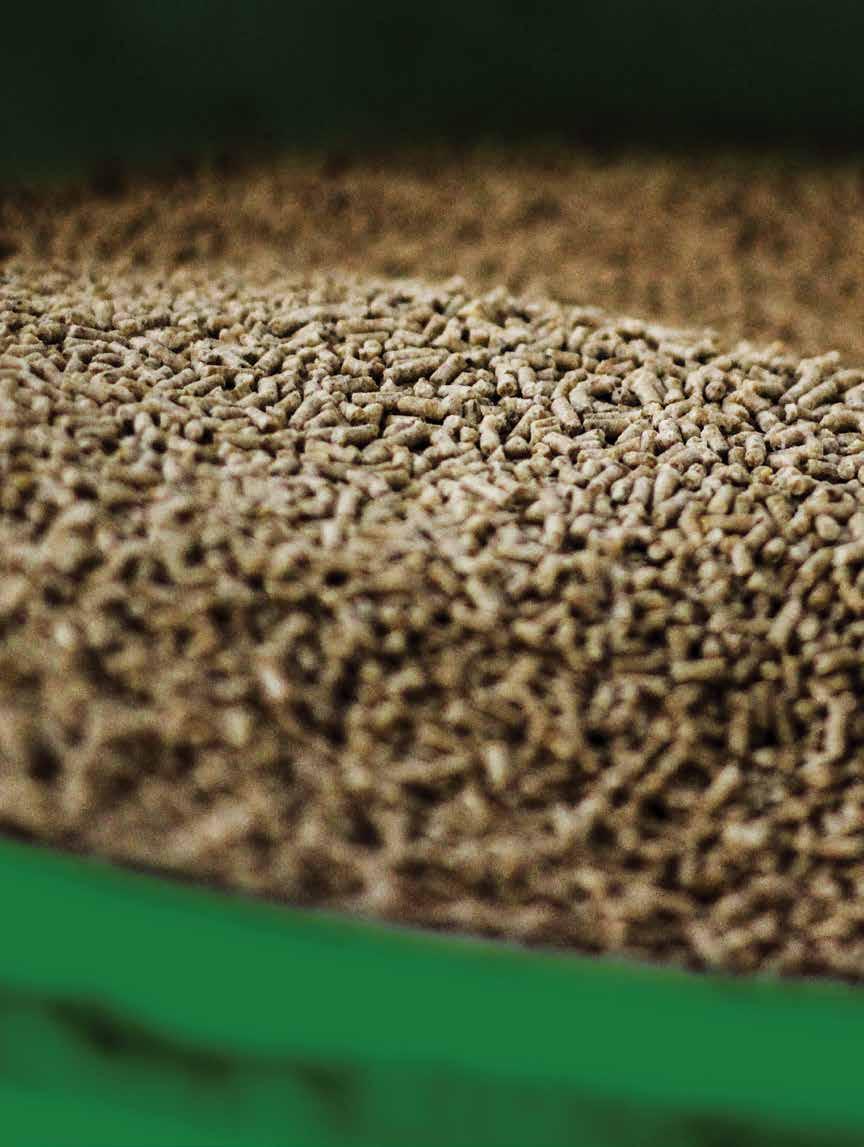
Who’s the No. 1 protein source in chicken feed? YOU are. That’s right. You’re winning.
All soybean farmers, including you, are really big in poultry and livestock feed. How? By pooling your resources through your soy checkoff. Learn how your soy checkoff is bringing tangible returns back to you and your operation at unitedsoybean.org/hopper
More than 200 farmers, lawmakers, legislative staff and ag industry stakeholders met to talk about potential legislation such as biofuel tax credits during the annual legislative breakfast.
In February, Indiana’s soybean checkoff program embarked on a mission to Indonesia to increase the state’s share of the 2.5 million metrics tons of soybeans exported to the Asian nation.
24
Soil erosion led farmer to increase conservation efforts
A weather event in 2007 changed the course of an Indiana farm, said Warren County farmer Rick Clark after he saw soil erosion damaging his fields after a one-inch rainfall.
The Indiana Pacers and its concessions supplier, Levy Restaurants, agreed to use high oleic soybean oil in food preparation for events at Gainbridge Fieldhouse – this year that included the NBA All-Star Game.
44
About the cover:
United Soybean Board (USB) member Tom Griffiths, who operates a small farm near Kendallville, Ind., has served nine years on the Indiana Soybean Alliance, and he was recently re-elected to his final three-year term on USB
ISA Membership & Policy Committee
Chair Vice Chair
Joseph Stoller, Bremen / D1 Dylan Christopher, Brookston / D1
Directors
Allen Buchanan, Fowler / D1 Mark Legan, Coatesville / D3
Kevin Kelley, Brookston / D1 Derika Lynam-Spaetti, Richland / D3
John Peters, Monticello / D1 Gary McDaniel, Boonville / D3
Denise Scarborough, LaCrosse / D1 Jason Misiniec, Bicknell / D3
C.J. Chalfant, Hartford City / D2 Larry Rusch, Vincennes / D3
Carey McKibben, LaGrange / D2 Roger Bommer, Brookville / D4
Steve Phares, Albion / D2 Kevin Burbrink, Seymour / D4
Jenna Scott, Muncie / D2 Chris Eck, Boggstown / D4
Brian Warpup, Warren / D2 Mike Koehne, Greensburg / D4
Mark Wenning, Cambridge City / D2 Keevin Lemenager, Monrovia / D4
Kevin Cox, Brazil / D3 Roger Wenning, Greensburg / D4

President Secretary
Chris Cherry, New Palestine / D6 J.R. Roesner, Ferdinand / D8
Vice President Treasurer
Tyler Everett, Lebanon / D7 Joe Tuholski, LaPorte / D2
Directors
Tom Murphy, Chesterton / D1 Scott Smith, Windfall / D5
Sarah Delbecq, Auburn / D3 Tyler Pottschmidt, Crothersville / D9
Alan Dunn, Michigantown / D4
Staff Credits
Editor / Dave Blower Jr. dblower@indianasoybean.com
Writer / Amie Simpson asimpson@indianasoybean.com
Creative Director / Carol Johnson
Indiana Corn & Soybean Post® is published six times per year by the Indiana Soybean Alliance and the Indiana Corn Growers Association.
For address corrections contact:
Indiana Corn & Soybean Post® 8425 Keystone Crossing, Suite 200 Indianapolis, IN 46240
Find us on Facebook Badge CMYK .eps
Phone: 800-735-0195 or 317-614-0377
Email: dblower@indianasoybean.com
For advertising information in the Indiana Corn & Soybean Post®, contact Dave Blower Jr. at 317-3473620 or dblower@indianasoybean. com. Comments and statewide news articles should be sent to the above address. Advertising space reservations must be made by the first day of the month preceding publication. In consideration of the acceptance of the advertisement, the agency and the advertiser must, in respect of the contents of the advertisement, indemnify and save the publisher harmless against any expense arising from claims or actions against the publisher because of the publication of the content of the advertisement.
facebook.com/indianaSoybeanAlliance facebook.com/IndianaCornGrowers
@Indiana_Soy @IN_Corn
 TJoe Stoller Chair
TJoe Stoller Chair
here’s a season for everything. For basketball fans, this is March Madness. The Super Bowl wraps up football season, and the World Series is the end of baseball season. As farmers, we live in the seasons. Many of us are preparing for planting season, and it doesn’t seem like harvest was that long ago.
As the chair of ISA’s Membership & Policy Committee, we keep track of the legislative season, too. On March 14, the Indiana General Assembly ended its 2024 legislative session kind of quietly. In the past few weeks, Gov. Eric Holcomb has been considering which bills to sign and which bills to veto.
For those of us following farm-related bills from the Statehouse, there isn’t too much to report.
House Enrolled Act 1183, the Foreign Ownership of Farmland bill authored by Rep. Kendell Culp (R-Rensselaer), was signed by Gov. Holcomb on March 15. The bill prohibits foreign adversaries, as defined by the U.S. State Department, from acquiring or leasing agricultural land. The final bill also prohibits land purchases and leases within a 10-mile radius of military installations. Exceptions were given to dual citizens, lawful permanent residents and residential rentals for university students and professors.
The Indiana Attorney General will handle suspected violations of illegally obtained land. While this bill got pushback from the Indiana Economic Development Corporation for potentially hurting current negotiations with foreign companies, exemptions were granted for lease renewals made before July 1, 2024.
The drainage handbook language contained in HB 1417, Agricultural Matters bill authored by Rep. Beau Baird (R-Greencastle), was inserted into the Department of

Natural Resources bill, HB 1401, which was signed by the governor on March 13.
Even though there wasn’t a lot of farm-related action in the Statehouse, that’s not necessarily a bad thing. The M&P staff and members were active in laying the groundwork for more important bills to fight for next year.
Among the more important bills we are focusing on next year is an income tax incentive bill for retailers, HB 1315. This bill was introduced in this year’s Indiana General Assembly. It would boost investment in modern fuel pumps and tanks and to create a wider range of fuel options for Indiana. The goal is to get this bill through the Indiana General Assembly in 2025.
If adopted, we believe this incentive will add more than $223 million in economic activity from biodiesel sales. The bill could grow demand for ethanol by 51 million bushels of corn.
Like many of us out there, this would mean a lot for my farm. Nearly all of my corn production goes into ethanol, and almost all of my soybean crop goes into biodiesel. We grow fuel as well as food.
I know it seems as though I say this a lot – of course the most important messages are repeated – but we need as many farmers as possible to become Indiana Soybean Alliance policy members. We can only accomplish our goal to make Indiana farms more profitable with more numbers behind us. When the senators and representatives in Congress and the Statehouse see how unified and strong farmers are, they work harder to get our bills adopted.
If you have questions about becoming a member, contact Khyla Goodman in our office at kgoodman@indianasoybean.com.

Looking for the best soybean seed genetics at a competitive price, with proven yields and no strings attached? Turn to IOM Grain. We are your ag input seed supplier of DONMARIO Seeds and your source for high-quality, high-per formance, GMO and non-GMO soybeans. Suppl ying 44% of the world’s soybean seed genetics, DONMARIO is one of only two independent seed genetics companies from DONMARIO Seeds, exclusively available through IOM Grain. These genetics are engineered and Indiana, Ohio and Michigan Star t your planting season strong from DONMARIO.
Contact IOM Grain today to purchase your DONMARIO soybean seeds for the 2024 growing season.
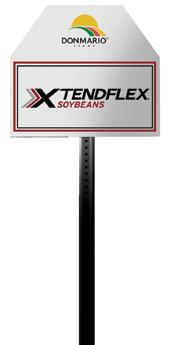


 TChris Cherry President Indiana Corn Growers Association
TChris Cherry President Indiana Corn Growers Association
he Commodity Classic is an interesting annual event. Leaders from corn, soybean, wheat, sorghum and equipment manufacturers get together to share information and plan for the future. More than 11,000 people attended this year’s event which wrapped up earlier this month in Houston, Texas.
Whenever that many farmers and ag stakeholders are in one place at the same time, it attracts both government officials and media. The 2024 Classic had plenty of both.
USDA Secretary Tom Vilsack was one of those government officials. This year, EPA Administrator Michael Regan joined him. Both spoke during the Classic’s General Session, and that’s the largest single gathering of farmers during the event.
Vilsack mentioned working toward year-round sales of E15, a blend of 15 percent ethanol with 85 percent petroleum. Most gasoline in America is blended with 10 percent ethanol. Vilsack also talked about Sustainable Aviation Fuel (SAF) and getting approvals for it from EPA. He said the environmental impact of SAF should be judged by EPA applying the GREET model. GREET is the Greenhouse Gases, Regulated Emissions and Energy use in Transportation, and it has been the rule for judging new fuels since 2021.
However, Vilsack did not mention any new initiatives for E15 or SAF.
When Regan addressed the crowd, he announced the creation of the EPA’s Office of Agriculture and Rural Affairs. Rod Snyder, who serves as EPA’s Senior Ag Advisor, will lead the new office. Snyder is a former lobbyist for the National Corn Growers Association (NCGA). We aren’t against improved communications between EPA and farmers, but it wasn’t “exciting” news.
The Classic was also an opportunity to talk to other corn growers from across the country. A lot of that talk

happened during planned events by the NCGA. The conversations that are had with leaders of the corn industry from other states is valuable for me. The more informed we are with issues that other states encounter are a beneficial learning tool for us.
Among those events was the NCGA Corn Congress. NCGA leaders ratified a new strategic plan for the organization, modernized its objectives and positioned the association to focus on increasing demand for corn. The vote to approve the new plan happened on Saturday, March 2 as Corn Congress concluded its Houston meeting. Other votes and work with the NCGA Policy book included support for the use of the GREET model to accurately show the greenhouse gas emissions of corn ethanol and continued support for a mandatory base acre update.
The current NCGA policy supports a mandatory base acre update to be included in the next farm bill. A resolution was offered to change this position to a voluntary update over several years. After debate on the delegate floor, the delegates chose to keep the current mandatory base acre update language.
Other resolutions of note, NCGA delegates passed resolutions to support policy that expands ethanol markets and encourages corn to be a preferred feedstock for SAF production.
There is a tremendous amount of work done in preparation for the Commodity Classic. Our staff does an excellent job of preparing us for the different meetings that we attend as well as the logistics of things. There are too many names to list that work to make this happen from staff that travels with us as well as the staff that stays home to keep things moving along. Our thanks to all of these individuals.
As I said earlier, the reason these opportunities happened is because we had thousands of farmers in one location at one time. Our numbers matter. If you’re not an ICGA member, send an email to Khyla Goodman at kgoodman@incorn.org.

At POET, we believe in cultivating communities and growing the local economy. We have been using biotechnology to create sustainable solutions from local agricultural products for 35 years – ensuring that rural farm families can continue to do what they love for generations to come.

POET purchases corn from local farmers to produce sustainable biofuels and bioproducts. There are five POET Bioprocessing facilities across Indiana: Alexandria, North Manchester, Portland, Shelbyville, and Cloverdale. | poet.com/grain

March is an important month in Washington.
It’s the month that cherry blossoms bloom to the delight of city residents and tourists alike, and many outdoor activities, such as marathons, take off, shutting down city streets on the weekends. This month is also a time when congressional and administration officials begin to unveil their plans for the year ahead. We saw the beginnings of this on March 7, when President Biden gave his State of the Union speech. The president released his proposed federal budget for FY 2025 several days later, even as Congress and the administration are at an impasse on parts of this fiscal year’s budget.
If the tone and tenor of the president’s address and the Republican response to that address are any indication of what we should expect in the year ahead, we should all fasten our seatbelts because it is going to be a bumpy ride.

To penetrate all the noise in the air in Washington, corn advocates are using ingenuity. Just as the president and members of Congress are setting their agenda for the year ahead, we’re reminding these policymakers of our objectives for 2024. Here is a sampling of our activities:
• Meeting with Key Leaders. Numerous corn growers from states in the heartland have visited Washington to meet with their state’s delegations to emphasize our priorities. NCGA board members, who will soon be in town for a scheduled meeting, also plan to meet with leaders in the administration and on Capitol Hill to drive home the importance of corn grower priorities.

The president, who has trailed in polls against his opponent, former President Donald J. Trump, gave nothing short of a campaign-style speech designed to rally his base and win over independents. Conspicuously absent were the usual olive branches or allusions to working together.
The speech was a reminder that we’re not just in an ordinary election year; we’re in an election year that will be unusually divisive. I have written at length in previous columns about how the divisions in this city are presenting all kinds of impediments to advancing legislation.
We can expect those challenges to grow exponentially in 2024.
This is a concern for farmers, who have numerous priorities before Congress, including farm bill reauthorization, passage of legislation ensuring yearround access to higher blends of ethanol during the summer months and advancement of the Next Generation Fuels Act.
• Launching Media Campaigns. To keep our messages front-and-center when we’re not meeting with key decision-makers, NCGA and state partners are running targeted ads in the D.C. metro area on important corn-centric issues. This includes the environmental and economic benefits of ethanol, our farm bill priorities and the innovative spirit of farmers and the role they play in environmental sustainability and the economy of rural America. Media campaigns like these round out a broader strategy to keep decision-makers engaged with corn grower priorities.
• Interacting with Congressional Candidates. Hopeful congress-bound candidates flock to D.C. to meet with stakeholders and interest groups to garner support ahead of their intended placement in an office on Capitol Hill. Because of our robust political action committee — Corn PAC — we have the resources to meet with potential partners and champions for our top priorities right here in the town they are striving to work in or stay in. This allows us to prime the pipes of policymaking to help ensure our members’ voices are heard and policy needs are met.
The intense disagreements between Democrats and Republicans have helped fuel delays in the government funding bills. Ideally, these would have been signed into law before the Oct. 1, 2023, fiscal year began. Instead,

a stopgap was approved that punted funding for four government agencies – including the USDA.
Congress must clear the deck on government funding before they will be able to move onto the farm bill and other corn grower priorities.
Leaders in the Senate and House have agreed to a $1.66 trillion government funding framework, but the details of how the money will be allocated will continue to be a challenge.
Supplemental funding legislation for Ukraine, Israel and Taiwan has further exposed intra-party disagreements within the Republican Party. Republicans in the Senate joined their Democratic counterparts to pass $95 billion in supplemental foreign funding. But House Speaker Mike Johnson (R-La.) has said the legislation will go nowhere unless funding for border security is included in the bill.
To put an exclamation point on all of this, the House voted to impeach Homeland Security Secretary Alejandro Mayorkas. The last time a cabinet member was impeached was 1876.
These are certainly not ordinary times.
While there is a lot at stake in Congress, we are also focused on the Administration where we’re watching rulemakings important to the future of the ethanol industry
and seeking science-based standards with our trading partners.
For example, we recently organized an effort to send a letter to President Biden cautioning him against prioritizing electric vehicles over biofuels, such as corn ethanol. The letter comes on the heels of a similar effort by auto dealers and as the administration has advanced rulemakings in multiple agencies which favor zero emission vehicles. The effort resulted in major media coverage.
We also continue to fight to eliminate trade barriers, such as the Mexican ban on biotech corn, and efforts to place and maintain tariffs on products, like fertilizers, that are widely used by farmers.
So, when people ask me how corn growers deal with the challenges that we are hit with on what has become a regular basis, my response is always the same: We shake it off.
While the next several months will be full of challenges, thanks to the fact that it is a particularly divisive election year, corn grower leaders continue to work hard to advance legislation that is important to rural economies.
We will keep you posted on developments in these efforts. So, stay tuned.
Here’s to March, spring and an election year full of twists and turns.

Across this country, U.S. soybean farmers are wrapping up a winter of meetings and busy preparing for the 2024 planting season. However, the fact that there’s been little movement on the farm bill in the current legislative year, especially with the uncertainty of elections and division in Congress, emphasizes how crucial it is for farmers to have strong advocacy and representation.

Under the order, Farmers can accept “existing stocks” — previously registered pesticide products currently in the United States that were packaged, labeled and released for shipment prior to Feb. 6 (the effective date of the District of Arizona’s vacatur of dicamba registrations) within set guidelines outlined in the order.
This is particularly important as farmers navigate the intricate and ever-changing regulatory landscape of agriculture.
With millions of dollars of product already on order and extremely limited alternatives available before spring planting, ASA was pleased by EPA’s swift actions to issue an existing stocks order on Feb. 14, and allow farmers planning to use dicamba product for 2024 to receive and use it this planting season.
This order from EPA is in response to the federal district court in Arizona Feb. 6 ruling that EPA made a procedural error in issuing 2020 dicamba registrations for over-the-top (OTT) use on dicamba-tolerant soybeans and cotton.
Because EPA did not offer a public notice and comment period before issuing the registrations, the court ruled the agency was in violation of the Federal Insecticide, Fungicide and Rodenticide Act and vacated 2020 registrations for XtendiMax, Enginia and Tavium.
EPA’s
Specifically, the order allows for the existing sale, distribution and use of existing stocks of the previously registered dicamba products that are currently in the United States and were packaged, labeled and released for shipment prior to the Feb. 6 court ruling date. In order to be eligible for use, stocks must be in the hands of retailers, co-ops, distributors or growers prior to the Feb. 6 date.
Under the order, farmers can use these existing stocks consistent with the cutoff dates from the previous registration, so up until June 30 in most soybeanproducing states. Cutoff for sales and distribution of existing stocks under the order ends one month ahead of the use cutoff, so May 31 for soybeans in most states.
FIFRA gives EPA the authority to issue existing stocks orders for products that are cancelled, which is now a major priority for the soybean industry. ASA also asks for the administration’s support of an appeal of the ruling and help in seeking to stay the ruling from taking effect pending appeal.
Immediately following the Feb. 6 decision, ASA engaged heavily on this matter in D.C. and led a letter to EPA signed by 26 soy state affiliates asking the administration for help.
proposed Herbicide Strategy is meant to bring herbicide registrations into compliance with the Endangered Species Act. While the agency’s proposal provides a framework for this goal, it does not estimate the ability of producers to comply with potential regulations.
EPA has proposed pesticide registration plans to meet its Endangered Species Act obligations that could significantly affect farmers’ livelihoods. With U.S. soybean farmers concerned over the impacts of these proposals, which include the Vulnerable Species Pilot Program (VSPP) and a draft Herbicide Strategy, the ASA sought a clearer picture of the potential costs the Herbicide Strategy could have — both financially and otherwise — if left unchanged.
In December, ASA conducted a survey of its farmer board members and a sample of soy growers from affiliate state soy organizations, analysis of which can be found in the Economist’s Angle column by ASA Chief Economist Dr. Scott Gerlt and Director of Government Affairs Kyle Kunkler.
EPA’s proposed Herbicide Strategy is meant to bring herbicide registrations into compliance with the Endangered Species Act. While the agency’s proposal provides a framework for this goal, it does not estimate the ability of producers to comply with potential regulations.
Similar to the VSPP, the picture painted by the ASA

grower survey clearly indicates the Herbicide Strategy’s requirements for pesticide application most likely would vastly and negatively alter farm production.
Approximately 99 percent of the producers who responded to ASA’s survey would have compliance obligations under the Herbicide Strategy: The news was not good. When soybean producers were asked about their ability to meet the proposed Herbicide Strategy obligations, a striking number were not meeting the compliance requirements of the proposal.
Data indicates approximately 80 percent of producers would be incompliant with the proposal and would face moderate to extreme costs to become compliant.
Given herbicide resistance issues and a lack of comparable options reported by survey respondents, farmers would be forced to adopt pricy mitigations, accept lower yields due to weed pressure, or need to stop growing crops requiring herbicides with high efficacy point requirements. The survey indicates significant, harmful impact on U.S. agriculture if the proposal is adopted in its current form.
To read the full Economist’s Angle by Gerlt and Kunkler, to online to the ASA’s website at https:// soygrowers.com/news_release_category/economistsangle/

Become a lifetime member of Indiana’s corn and soybean policy groups
The Indiana Corn Growers Association (ICGA) and the Indiana Soybean Alliance’s Membership & Policy Committee (M&P) represent our state’s farmers in the legislative halls in Indianapolis and Washington, D.C. These organizations need your membership to influence federal and state lawmakers.
Indiana soybean and corn growers can now save money and eliminate the hassle of annual renewals by purchasing a LIFETIME MEMBERSHIP to both ICGA and M&P. For only $1,700, you can be a member of both ICGA and M&P for life!
Anyone interested in buying this membership, should contact Industry Affairs Outreach Manager Khyla Goodman by phone at 317-614-0377 or by email at goodman@indianasoybean.com. Or, you can go to our website, www.incornandsoy.org/ policy-center/become-a-policy-member, to join!
Lifetime Members:
Phil Ramsey
Courtney Kingery
Matthew Lucas
Tyler Everett
David Gottbrath
Mike Sprinkle
Jeff Troike
Jim Douglas
Michael Steinbarger

Sam Caldwell
Mark Nigh
Alan Dunn
Mason Gick
Aaron Johnson
Nathan Luallen
Sam Mehringer
David Wenning

Mark Wenning
Creed Gunn
Andrew Fansler
Kent Burton
Russell Anderson
Troy Hattery
Mark Bacon
Ronald Sutherlin
Jim Douglas, Flat Rock, Ind., farmer
“I was 60 years old when I was first elected to the ISA board. I thought that would be a good time to get involved. I had no idea that I would learn so much and meet so many good people involved in agriculture. From policy to domestic markets to international trade our policy organizations truly represent Indiana farmers.”

Indiana is blessed with great soil and even greater farmers. We don’t just feed our fellow citizens, we feed the world.
I’m committed to maintaining that Hoosier leadership. Congress is continuing its work toward a new farm bill, but it’s important to remember that there are a lot of other policies that keep our farmers and ranchers competitive in the global marketplace.
For example, as a member of the House Transportation and Infrastructure Committee, one of our key tasks in 2024 is to pass a Water Resources Development Act (WRDA). This legislation is typically passed every two years and authorizes water-related projects, such as dredging ports and harbors, maintaining locks and dams, and developing flood protection.
For Midwestern farmers, these projects ensure that harvests can be transported through our inland waterways to the Mississippi River and onward for processing and/ or export. This efficient transportation gives American farmers a huge competitive advantage over foreign producers.
Government overreach, on the other hand, represents a threat to our agricultural competitiveness.
Bureaucrats in Washington have no shortage of bad ideas that threaten to bury farmers and ranchers under red tape, whether it’s resurrecting the Waters of the United States (WOTUS) rule that
creates uncertainty, attempting to impose radical climate mandates, or trying to take important pesticides off the market on unscientific grounds.
The U.S. House of Representatives has been working hard to push back on this radical agenda, passing legislation and sending legal briefs in support of court challenges. I also introduced H.R. 4956, the Farmer-Informed WOTUS Act, which would require the USDA to solicit feedback from farmers and ranchers on WOTUS to ensure that their voices are being amplified in this conversation.
Ultimately, our global competitiveness is only truly effective with a level international playing field and open markets. This means ensuring that countries don’t erect unscientific barriers to our exports. Last year, I highlighted an effort I was leading with my fellow Hoosier, U.S. Rep. Greg Pence (District 6), to make sure that the United States stood up to Mexico’s proposed ban on genetically modified corn.
I was pleased to see the U.S. Trade Representative initiate a trade case against Mexico under the U.S.-Mexico-Canada Agreement (USMCA). Though the case is still ongoing, we cannot allow unscientific policies and scare tactics like that to proliferate.

There are other looming threats too, like the European Union’s attempts to export its radical green farming regulations that tie producers’ hands and could even pose a risk to global food security.
It’s an honor to be a voice for the hardworking Hoosier farmers and ranchers of Indiana’s Second District. I always look forward to hearing their thoughts, and I will continue to value these partnerships as I advance our shared priorities back in Washington.

Greetings to my fellow Hoosiers. As I reflect on my time as your governor, nothing has been more reliable or more constant than the drive and commitment of our local Hoosier farmers.
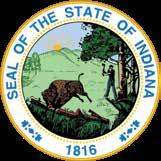
Agriculture has always been the lifeblood of our Hoosier economy, with commodity agricultural production worth more than $18 billion right now. It’s not lost on me the hard work it takes to feed the world, and I thank each and every one of you for it.
I had the pleasure of meeting with your own Courtney Kingery recently, who emphasized how Hoosiergrown commodities and livestock continue to make an immense impact on a global scale. During my international travels where we work to attract new investments to Indiana, I am always thrilled to share the story of our farmers who make it all happen and look for new opportunities to get our Hoosier products out there.
Back here on the home front, I’ve been thankful for the knowledge and expertise of Don Lamb, our Indiana State Department of Agriculture Director. As a farmer himself, Don provides invaluable input and is our boots on the ground here in Indianapolis as we work together to better the economic outlook for farmers in every corner of our state.
There is no question
that a lot has changed in Indiana through the years, but in true Hoosier fashion we keep our nose to the grindstone to keep up with our ever-changing world, especially in regard to sustainability. Progress in sustainability and our economy go hand in glove, and nowhere is that more evident than the ag sector as farmers adapt to the needs of tomorrow.
It’s no secret that farmers are some of the most environmentally friendly business owners in our state. You all work hard to keep your land productive and prosperous, so your business can continue to grow.
At the state level we will continue to support farmers through initiatives like Clean Water Indiana that supports local efforts to improve soil structure and water quality. As sustainability and conservation continue to be at the forefront of economic and business production, your efforts are a strong selling point that drive businesses to plant their roots in the Hoosier state.
Conservation is crucial to economic development. People want to be around beautiful landscapes and have access to clean water, healthy air and GREAT food! In Indiana, we’re laser focused on creating a sustainable future, both for our economy, and for our planet.
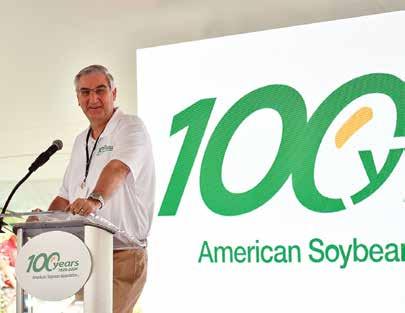
You can count on me to put the pedal to the medal until the checkered flag waves, advocating and uplifting our Hoosier farmers, preserving our natural resources, and together, trailblazing towards a sustainable future for generations to come.
With steam rising from plates of delicious breakfast food, farmer leaders and staff with the Indiana Corn Growers Association (ICGA) and the Indiana Soybean Alliance’s Membership & Policy Committee (M&P) discussed hot topics with state lawmakers on the morning of Feb. 5 at the annual Bacon Bar and Brunch legislative breakfast in the Indiana Statehouse.


More than 200 farmers, lawmakers, legislative staff and ag industry stakeholders met to talk about potential legislation such as biofuel tax credits, restrictions on foreign ownership of farmland, and updating Indiana’s handbook on drainage issues. In addition, ICGA and M&P touted prolivestock policies because Indiana’s livestock industry is a large and reliable customer for the state’s corn and soybean growers.
“Livestock farmers are a valued customer for Indiana soybean and corn growers,” said M&P Chair Joe Stoller, a farmer from Bremen, Ind. “A lot of our soybean and corn crops go to feed livestock in Indiana. During our Bacon Bar legislative breakfast, we can easily explain to people who are not from the farm the connection between livestock farmers and row-crop farmers.”
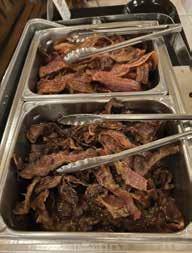
Along with traditional bacon, applewood smoked bacon, turkey bacon, beef bacon, candied bacon and bacon with cracked pepper and rosemary was served.
All of the breakfast foods served at the event were connected to Indiana agriculture. The Brunch menu featured items from the beef, dairy and poultry industries. Along with traditional bacon, applewood smoked bacon,
turkey bacon, beef bacon, candied bacon and bacon with cracked pepper and rosemary was served. Other menu items were an egg casserole with bacon, cheddar cheese and caramelized onions; a vegetable and egg casserole with spinach, red peppers, broccoli and zucchini; a sweet corn casserole with duck sausage and maple syrup; and a yogurt parfait station with granola and fresh berries.
Sponsors donating food include Maple Leaf Farms, Perdue, American Dairy Association of Indiana and Indiana Packers Corporation. Financial supporters were Farm Credit Mid-America, Corteva Agriscience, Indiana Pork, Indiana Beef Cattle Association, Indiana Dairy Producers, Indiana Ethanol Producers Association, Indiana Farm Bureau, Indiana State Poultry Association, Bose Public Affairs Group and the United Soybean Board (catering sponsor).
Promoting the interests of Indiana’s corn and soybean growers is the event’s purpose.
“We enjoyed many good conversations with state legislators and their staffs on a variety of farm issues,” said ICGA President Chris Cherry, a farmer from New Palestine, Ind. “Many senators and representatives attended and engaged with the farmers here. ICGA is and should be the voice for Indiana’s corn growers. This event is a good place to start conversations, build relationships
and promote the policies that are important to farmers.”
A new set of proposed laws and regulations in the Indiana General Assembly each year will catch the eyes of M&P and ICGA staff. For 2024, the organizations are following a proposed tax credit to help expand biofuels such as ethanol and biodiesel. The bill, HB1315, would provide tax credits for the sale of higher ethanol blends, the sale of blended biodiesel or renewable diesel, and the blending of biodiesel or renewable diesel. Both ICGA and M&P support this bill.
Authored by State Rep. Craig Snow (R-Warsaw), HB1315 received a hearing in the House Agriculture and Rural Affairs Committee. Both Stoller and Cherry were on hand to testify in support of the bill.
The two leaders explained this bill would bring many benefits to farmers and rural communities. Since HB1315 would have an impact on the state budget, it only received a hearing. Budget items will be considered next year when the General Assembly develops the biennium budget for 2025-26.
“Many of the benefits of biofuels, and the impact this market has on corn and soybean farmers, was presented to the committee,” said Steve Howell, senior director of industry affairs for M&P and ICGA. “The hearing is a positive step to build more markets for corn and soybeans here in Indiana, and we will continue to work with legislators over the summer months to provide information on this important market.”
Agriculture adds an estimated $31.2 billion to the state’s economy, as reported by the Indiana State Department of Agriculture (ISDA). Indiana’s top two ag commodities are its soybean and corn crops. Ethanol and biodiesel are two leading products derived from those crops.
diesel have reduced carbon emissions by 11,000 tons since 2021. Indiana is the fifthlargest producer of U.S. ethanol –generating more than 1.4 billion gallons per year. The Hoosier State produces nearly 8 percent of the total U.S. ethanol output. There are 15 biorefineries in the state. Collectively, they consume about 43 percent of Indiana’s total corn crop – more than 450 million bushels. A blend of 15 percent corn ethanol with 85 percent petroleum gasoline, also known as E15, cuts greenhouse gas emissions by 455,000 metric tons each year.

Indiana is the sixthlargest biodieselproducing state with more than 289 million pounds of soybean oil grown annually going to biodiesel production. Vehicle fleets using a blend of 20 percent soy biodiesel with 80 percent petroleum

“Biodiesel and ethanol produced from soybean and corn grown on farms across Indiana and processed here in the state are an immediate solution to providing Hoosiers economic relief at the pump while lowering greenhouse gas emissions,” Howell said.
“An income tax incentive for retailers would boost investment in modern fuel pumps and tanks, which will create both a wider range of fuel options for Hoosiers and increased demand for corn and soybeans grown by Indiana farmers. These clean fuels add power to our state’s economy.”
Increasing the blend of ethanol into gasoline from 10 to 15 percent would add $377 million to Indiana’s economy and boost demand for Indiana corn by an additional 51 million bushels. At the pump, Hoosier motorists would save 5-10 cents per gallon with higher blends of ethanol, such as E15, if the Biofuels Tax Credit is adopted this year.
ICGA and M&P rely on event sponsorship and membership dollars to advocate on behalf of Hoosier farmers. Anyone interested in joining these policy organizations should contact Khyla Goodman, Industry Affairs Outreach Manager for M&P and ICGA, at 317-6140377 or email kgoodman@indianasoybean.com
The Indiana Soybean Alliance Membership and Policy (M&P) Committee and the Indiana Corn Growers Association (ICGA) hosted three Coffee Shop Talks throughout Indiana in February. The policy organizations worked with local farmers and agribusinesses to facilitate small group meetings with federal legislators to offer farmers an opportunity to have open discussions on ag policy issues.
The first Coffee Shop Talk was on Friday, Feb. 2 in Valparaiso, Ind. Farmers and representatives from county soil and water conservation and land trust organizations joined in conversations with U.S. Rep. Frank Mrvan (D-Dist. 1) regarding infrastructure, exports and trade topics. A vital topic to farmers in this region of Indiana is accessibility and distance to grain elevators.
Farmer leader and ICGA director Tom Murphy shared that he transports his commodities 85 miles one-way to Warsaw, which may pose a risk to his products. He expressed a need to the Congressman for more options in the area for his grain.
Another Coffee Shop Talk was on Friday, Feb. 9 at Next Generation Inc. in Greensburg, Ind. Around 14 farmers gathered at the agricultural service to talk farm bill, biofuels and trade with U.S. Rep. Erin Houchin (R-Dist. 9). Decatur County farmer and ISA director Mike Koehne informed Houchin that while creating opportunities to export product

through inland waterways remains a priority, it is also vital to get product, like fertilizer, in for growers. Houchin expressed support for investing back into Indiana’s infrastructure.
More than 25 farmers and agriculture business professionals shared refreshments and ag policy discussions with Sen. Mike Braun (R-Ind.) at Top Crop Alliance, a Pioneer dealership in Flat Rock, Ind., on Feb. 21. Braun discussed many agriculture issues with attendees, including the 2024 Farm Bill, the future of biofuels, EPA’S Draft Herbicide Strategy and foreign trade.
Braun also shared his priorities, like access to broadband, and compared it in importance for rural areas to the access to electricity in the last century. He also provided more insight on his bill regarding the foreign investments in U.S. agricultural land – AFIDA Improvements Act of 2024. ISA Policy Committee and ICGA express appreciation to Pioneer and First Farmers Bank & Trust for sponsoring the event.
A final Coffee Shop Talk, sponsored by First Farmers Bank & Trust, is planned for March 25 with U.S. Rep. Greg Pence (R-Dist. 6).
M&P and ICGA also look forward to hosting the summer Shop Talk series in July and August at Hoosier farms to continue these important conversations on state and federal issues affecting Indiana growers. Contact Emily McNiff at emcniff@indianasoybean to learn more.


Renewable biofuels, such as corn ethanol, biodiesel and sustainable aviation fuel (SAF), are immediate climate change solutions. The Indiana Soybean Alliance’s Membership & Policy Committee (M&P) and the Indiana Corn Growers Association (ICGA) tout more opportunities for renewable biofuels.
Biodiesel and ethanol produced from soybeans and corn grown on farms across Indiana and processed in-state not only lower greenhouse gas emissions, but they also provide Hoosiers economic relief at the pump and increase demand for corn and soybeans grown by Indiana farmers.
An income tax incentive bill for retailers (HB 1315) was introduced in the 2024 session of the Indiana General Assembly to boost investment in modern fuel pumps and tanks and to create a wider range of fuel options for Indiana. The goal is to get this bill through the Indiana General Assembly in 2025.
Biofuels are also a key market for soybean oil. Biodiesel and renewable diesel made from soybeans may reduce greenhouse gas (GHG) emissions by 74 percent, and Indiana vehicle fleets using B20 have reduced carbon emissions by more than 11,000 tons since 2021. Indiana produces more than 100 million gallons of biodiesel annually.
While Indiana is a leading biodiesel production state, there is an opportunity for growth in selling at the pump. Indiana soybean farmer leaders support several federal policies that will help keep biofuels competitive in U.S. fuel markets:
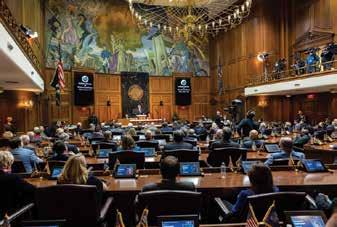
Indiana General Assembly finished its business for 2024 on Friday, Feb. 8. The Biofuels Tax Incentive proposal touted by M&P and ICGA can only be adopted in a budget year. The Assembly will build its next biennial budget in 2025.
If this incentive is adopted, it will add more than $223 million in economic activity from biodiesel and grow demand for 51 million more bushels of corn for ethanol production. As M&P and ICGA work toward in-state biofuel legislation in the current session, Indiana corn and soybean farmer leaders are also working toward biofuel priorities on the federal level.
Indiana corn farmers believe the use of higher blends of ethanol will improve engine performance and reduce environmental impacts – all at a lower cost to consumers. Also, the quickest way to increase corn grind is through expansion of ethanol use. There are several federal priorities that ICGA leaders are actively discussing with legislators on Capitol Hill. These include:
• Expanding market access through the Renewable Fuel Standard (RFS)
• Seeking permanent year-round E15 access
• Offering market-based policy rewards through the Low Carbon/Clean Fuel Standard
• Passing the Next Generation Fuels Act
• Increasing annual volumes for biomass-based diesel and advanced biofuels in the RFS
• Funding for the Biodiesel Fuel Education Program in annual appropriations legislation
• Adopting the Federal Biodiesel Tax Credit to help grow the biodiesel industry
Additionally, the U.S. Department of the Treasury issued guidance on the Sustainable Aviation Fuel Credit (40B) established by the Inflation Reduction Act (IRA) in midDecember. This progress is positive news for soybean farmers as members have pushed for use of the GREET model to determine eligibility for the SAF Credit. EPA will work with other agencies to develop new GREET methodology during the next couple months for products that incorporate soybean feedstock.
ICGA and M&P are committed to continuing the conversations of farmers’ biofuel priorities, as well as other policy issues affecting Indiana agriculture and rural communities.
Membership dollars and the added numbers of farmers across Indiana empower M&P and ICGA to positively influence policy and regulatory matters impacting the U.S. soybean and corn industry. The policy organizations are farmers’ representatives with lawmakers while farmers are growing crops.
The Commodity Classic is a little like a three-ring circus. While the spotlight is fixed on the trapeze artists flying above the center ring, there are still entertaining jugglers and acrobats performing in the outer rings. For the more than 11,500 farmers and ag stakeholders who attended this year’s event in Houston, Texas, Feb. 28-March 2, so much was going on it was easy to miss something.
The Commodity Classic is organized and presented by five membership associations: the National Corn Growers Association, the American Soybean Association, the National Association of Wheat Growers, the National Sorghum Producers and the Association of Equipment Manufacturers. The Classic features a large and growing trade show, national meeting space for each commodity association, educational seminars and a variety of entertainment options.
For many years, the Indiana Soybean Alliance (ISA), the Indiana Corn Marketing Council (ICMC) and the Indiana Corn Growers Association (ICGA) have participated in the annual event. In 2024, these groups hosted several dozen Hoosier farmers along with staff during the week-long event.
Although it was announced during the Ag Policy Summit last summer, Ted McKinney had been unable to receive his Friend of Farmer award from ISA’s Membership & Policy (M&P) Committee and ICGA until a reception on Thursday, Feb. 29 at the American Soybean Association (ASA) booth at the trade show.
McKinney, who now serves as the CEO of the National Association of State Departments of Agriculture, was selected for the award due to his many years of service to Indiana agriculture. For 19 years he worked for Dow Agrosciences and 14 years with Elanco Animal Health in various roles. His career in government began in 2013 when he was appointed by Gov. Mike Pence to serve as Director of the Indiana State Department of Agriculture. His political career continued when President Donald Trump nominated him in July 2017 as USDA Under Secretary for Trade and Foreign Agricultural Affairs.
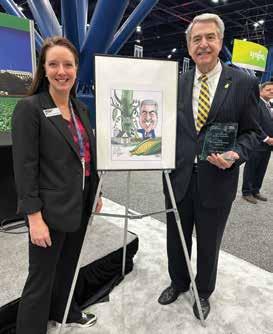
Ted McKinney, who now serves as the CEO of the National Association of State Departments of Agriculture, poses with ICGA and ISA CEO Courtney Kingery after receiving his Friend of Farmer award on Feb. 29 in the ASA booth at the Commodity Classic Trade Show.
“The Commodity Classic is a great time for farmers to get together to discuss agriculture on a national level,” said ICMC President Tim Gauck, a farmer from Greensburg, Ind. “This year’s show featured many unique events for Indiana’s corn and soybean farmers. We talked with companies trying to expand the use of ethanol and sustainable aviation fuel. And we heard from the administrator of the EPA and the USDA secretary about a new office that caters to farmers. This was a very productive event.”
The following is a round-up of various events from the 2024 Commodity Classic.
McKinney is the sixth person to earn this honor. Previous winners include State Rep. Ed Soliday, U.S. Sen. Joe Donnelly, U.S. Rep. Jackie Walorski, State Sen. Jean Leising and State Rep. Don Lehe.
“Two words: special and humbling,” McKinney said. “First, just the fact that only six of these awards have been presented, and then seeing the list of those who received it are people I held up as icons in Indiana agriculture. So, to be among them is pretty special, and I’m honored.”
As has been his custom for the past couple of years, USDA Secretary Tom Vilsack addressed the General Session of the Commodity Classic on Friday, March 1. This time,
though, he brought along a fellow leader in government –U.S. Environmental Protection Agency Administrator Michael Regan. Vilsack and Regan announced the creation of a new Office of Agriculture and Rural Affairs within the EPA.
Regan touted the new office as “an important step that will help solidify EPA’s relationship in the agriculture sector for the future.” Rod Snyder, a former lobbyist for the National Corn Growers Association (NCGA), will lead the office.
“We are excited that (Vilsack and Regan) both joined us here at the Commodity Classic and addressed the farmers,” said Springport, Ind., farmer Matthew Chapman, who is a past ISA chair. “This is the first time we’ve ever had the EPA Administrator here. It does feel like they’re heading in the right direction. They’re near the finish line.”
The USDA and EPA leaders, however, did not mention much about advancing production of Sustainable Aviation Fuel (SAF) or allowing year-round sales of E15, a blend of 15 percent ethanol with 85 percent petroleum. Vilsack said he expects more details on both as the year progresses. He wants the programs to be reliable and beneficial to U.S. farmers.
“I expect things to move slowly when the government is involved,” Chapman added. “But the words Secretary Vilsack used were ‘measure twice, cut once,’ and I do hope they’re taking that approach. They’re trying to do it the right way. Trying to make sure everything’s on the right path and, most of all, the American farmer is protected through the process and can be a beneficiary of all these new ideas.”
With so many farmers and ag stakeholders in the same place at one time, talk of a long-overdo farm bill was common. Ferdinand, Ind., farmer J.R. Roesner said he expects many U.S. farmers have the same goal for 2024 – seeing a new farm bill adopted. He is a member of the NCGA’s Corn Board and a director on both the ICMC and ICGA boards.

nets through ARC and PLC that farmers need. Especially given the downturn in farm prices here.”
Indiana farmers Mike Koehne and Don Wyss talked to farmers about growing specialty crops such as high oleic soybeans. Koehne is a farmer from Greensburg, Ind., and an ISA Board director. He is also on the ASA board and a member of the Soy Transportation Coalition. Wyss is a farmer from rural Allen County, Ind., and he is a director on the United Soybean Board, the national soybean checkoff. Both farmers referred to the positive impact of premiums paid for farmers for growing high oleic soybeans.

“We’re continuing to push for passage this year,” Roesner said. “We’re really focusing in on our priorities with crop insurance, with some of the foreign market development and market access programs to help trade promotion, and also finding ways we can improve those safety
“The high oleic program has had checkoff funds invested into it for many years, and that investment has been significant,” Wyss said. “When you consider the premiums that have been paid back to farmers easily out-distances that investment.”
Koehne agreed. “We grow high oleic soybeans on our farm. As a small farm operator, the premiums paid for these beans help a lot. This really brings value back to our farm.”
While participating in a podcast, Putnam County, Ind., farmer Mark Legan discussed the differences between the terms stewardship and sustainability. Legan grows soybeans and corn and is a pork producer. He’s an ISA Board director and an executive board member of the U.S. Meat Federation.
“So, among the core values of our farm, one of those is stewardship. We established that about 15 years ago before sustainability was a sexy word to use,” Legan explained. “I like the word stewardship because it talks about taking care of our animals, taking care of the soil and the water and taking care of our community. We feel very fortunate in Putnam County. We have a progressive group of producers adopting no-till as far back as 20-25 years ago – and even cover crops in the last 12-15 years. On our farm, we use cover crops on every acre after corn and soybeans.”











Those who choose to ride bucking horses and bulls soon understand things sometimes don’t work out the way they planned or visioned. When that happens, the only thing you can do is think about what you did wrong, regroup and get back on with a different attitude.
Kendallville, Ind., farmer Tom Griffiths understands this principle both figuratively and literary. For many years, Griffiths has interacted with and worked for Indiana farmers in several roles.
From 2010-2018 he served as one of 24 board members elected to the Indiana soybean Alliance (ISA) Board of Directors. In 2017, he began representing all U.S. soybean growers as a director on the United Soybean Board (USB). He was appointed for his final three-year term on the USB board in 2023.

For many years Griffiths had no plans of ever being a farmer. He was raised on a Noble County farm near the town of Avilla. Griffiths described his family’s operation as a “large grain and livestock farm.” He said his family worked hard, and “and it was a wonderful life. We didn’t want for anything.”
As a senior in high school in the fall of 1980, Griffiths’ father, Glen, was diagnosed with cancer. In January 1981, Glen died.
“That spring was kind of a blur for me,” Griffiths said. “Listening to the excitement of my classmates with graduation only weeks away; where they would attend college, and who they would take to the prom. All I could think about was my mom’s broken heart; the inevitability that we would have to sell the farm. Even though I thought we had plenty, I soon learned the bank owned the majority of everything.
“My parents did a good job of keeping their financial status away from me – not to mention my mom’s health was deteriorating fast. We soon sold the farm, and it wasn’t long until Mom was reunited with my dad.
“At this point, the last thing I wanted to do was become a farmer. After the smoke cleared and banks and hospitals were paid, my inheritance was somewhere around $200 and a 1971 Pontiac Catalina. And I was homeless. To see two people work that hard all their life and die with nothing but worry was something I wanted no part of.”
Griffiths is eternally grateful to a family friend who understood his situation and offered him a house to live in rent-free. The house belonged to an elderly gentleman who moved to an assisted-living facility.
“This gave me that opportunity to regroup,” he said. Griffiths received a degree in metallurgical engineering on a scholarship he earned in high school and worked as a metal fabricator.
But a wild spirit inside him was leading him elsewhere. “So, I became a professional Cowboy,” he said. Griffiths smiled and added that people are often surprised to hear he traveled the rodeo circuit. He competed in three events – bareback horses, saddle broncs and bull riding. “You know I worked all week then traveled to rodeos all weekend with little or no sleep to make sure I made it to work on Monday morning,” he said.
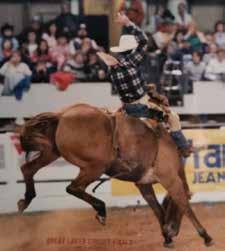


“I traveled a lot; the money was okay. There was no lavish lifestyle for me. I spent my nights in that Catalina. I loved that car. I saved everything. These days I stay in nicer hotels. ISA and USB want to keep their directors safe. One of the things I do every time I travel for the board is walk outside of our hotel and know there is another part of town – a part of town where things are not so glamorous. You might say the other side of the tracks. I know I’ve been there, and I know those people.”
Griffiths doesn’t refer to himself as a cowboy anymore. That was a long time ago, and he’s retired. “I was lucky I really didn’t have any major injuries, but all those little ones add up, and I feel all of them now,” he admitted.
Although rodeo life was a truly fantastic experience, Griffiths always knew it was a short-term career. “Being a professional cowboy was a lot of fun, but I was smart enough to know your longevity in a sport like that is limited,” Griffiths explained. “At some point, I would need to grow up.”

Griffiths married his high school girlfriend in December 1988. “Yeah, she stayed that long,” he said. “We always knew we wanted a family, and there is no better place to raise one than on a farm.”
In August 1988, he saw an ad in the paper for a bankowned property that was taking sealed bids.
“I didn’t have any credit, no co-signer, but I had money – only not enough,” Griffiths said. “That’s when another friend of my parents stepped in. He was the loan officer at the bank and found a way to lend me what I needed to honor my sealed bid.”
Griffiths made himself a promise that he would never be in the same financial position as his parents, and he would never make a decision that would keep him awake at night. With no one to fall back on, financial mistakes were not an option. Griffiths won that bidding process and suddenly owned 80 acres two months before he and Kim were married. Those acres are the anchor to his 350acre farm that he owns and operates today along with an additional 200 rented acres. Slowly and deliberately, Griffiths has bought ground near his 80 acres to grow his farm.
That is how Arrow G Farms got its start. In addition to soybeans, corn and hay, Griffiths also has a small feedlot of cattle. He grew up only five miles from where he now lives. In 1994, the Griffiths had their only child, Glen. Although Griffiths didn’t plan to farm, and didn’t plan to live in Noble County, Griffiths is pleased with his decisions.
“Kim and I were right about raising our son on a farm; there is no better place,” he added.
Kim has an off-farm job as a teacher. Glen is married and lives in Fort Wayne with his wife, Abby. Glen works as a seed salesman for Wyckoff Hybrids and runs crop applicators for a grain elevator in Ohio.
Although he is a supporter of Indiana’s checkoff, there was a time Griffiths was skeptical about who the checkoff was and what they were doing with farmers’ money, more importantly, his money.
“I would say around 15 years ago I was reading The Farmers Exchange, and I saw were the Indiana Soybean Alliance was hosting a free breakfast near Shipshwana, a town where we hauled hay every week,” Griffiths said. “I figured, if nothing else, haul a load of hay. I could get some of my checkoff back with their breakfast and maybe score a couple of doughnuts.”
He said ISA was taking applications for farmers interested in becoming board members. “I didn’t really know where my money was going, so I filled out an application.” he said.
After nine years on the ISA board, two as chairman and seven years on the USB board, Griffiths said he’s earned an education and gained respect for the soybean checkoff program. He noted that checkoff work has created new products like high oleic soybeans that provide a premium per bushel for Indiana farmers. The checkoff has invested in on-farm research that has led to yields increasing 25-30 bushels per acre in a short period of time. And, perhaps most importantly, checkoff works with partners such as the U.S. Soybean Export Council to find new markets for our soybeans.
“Stressing the fact if your end users are truly interested in a complete, sustainably sourced soybean, then you need look to look no further,” Griffiths said of checkoff work. “U.S. soybeans are the most sustainably raised and most complete soybean in the world.”
He said ISA and USB have poultry and livestock partners, as well.
Poultry is the No. 1 customer of U.S. soybeans – consuming nearly 67 percent of the crop. The USA Poultry and Egg Export Council helps to create worldwide markets for U.S. eggs and poultry products. The U.S. Meat Export Federation exporting soybeans though meat products such as beef, pork and lamb. These value-added products are vital to the profitability to U.S. soybean farmers, Griffiths explained.
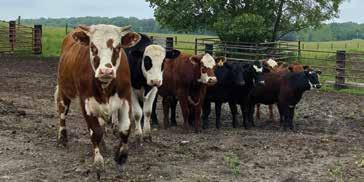

Griffiths, 61, doesn’t think he will pursue any other positions with checkoff commodities organizations. “I believe in term limits – even my own,” he said.
Griffiths sees U.S. agriculture at a point where the road splits. There are two distinct paths ahead. One is extremely positive, and the other one is kind of dark. Griffiths believes agriculture, at this moment, is going down the wrong road.
Generally, that road includes a focus on out-producing other countries instead of growing a better crop, more tailored to consumers’ wishes. Also, the wrong road includes commodity groups competing with each other instead of finding unity on legislative issues.
Unity is the key to the positive path, he said. Griffiths added that farmers should define the terms they live by – such as sustainability. He believes agriculture would be favorably compared to the airline business, the automotive industry, warehouse centers and others.
“People who don’t know me usually think of me as a pessimist,” he said. “We can’t rely on out-producing our competitors, that boat has sailed,” Griffiths said. “We need to focus on growing better products tailored to consumer demands. All sectors of our industry need to become unified in our messages and definitions that are beneficial to agriculture.”
He added that environmental groups have the desire to score agriculture separately from other industries. Griffiths said that must not happen. When measured against all layers of society, agriculture wins on all levels. He said commodity and livestock groups need to stop pointing fingers at one another.
“The last thing they want is agriculture united,” he said.
“My past has made me more of a realist with a little different thought process. I do feel agriculture will choose the right path with a brighter future. I just never said it would be easy.”
U.S. export negotiators often say that the key to any deal is building strong relationships. In February, Indiana’s soybean checkoff program, the Indiana Soybean Alliance (ISA), embarked on a mission to Indonesia to accomplish that step in a much larger goal.
In mid-February, ISA led a 10-person delegation to the capital city of Jakarta and other points in Indonesia to meet with potential soybean buyers and tour various facilities. At present, the United States exports 2.5 million metric tons of soybeans to Indonesia. The goal is to increase Indiana’s share of that export to Indonesia, according to Ed Ebert, ISA’s senior director of market development.
“The importance of it can’t be understated in terms of its overall contribution to the amount of soybeans that are exported out of the United States,” he added. “It is, by far, the largest consumer of U.S. soy in the form of No. 1 yellow soybeans, which they use to make food products here in Indonesia, principally tofu and tempeh.”
The effort to expand sales of Indiana soybeans is being assisted by the USDA’s Regional Agricultural Promotion Program (RAPP), which provided $1.3 billion to U.S. farmers to diversify their export markets.
In addition to Ebert, the delegation included:
• Jim Douglas, a farmer from Flat Rock, Ind., and a United Soybean Board (USB) director
• Mayasari Effendi, an Indonesian native, ISA consultant and Greensburg restaurant owner
• Nick Stewart, owner and partner of S&G Seeds
• Andrew Sherman, International Trade Director for Indiana State Department of Agriculture
• Grant Fausset, Pence Group, District Sales Manager
• Josh Marsh, Mayor of the City of Greensburg
• Bryan Robbins, Director, Economic Development of Greensburg and Decatur County
• Adam Gerdes, Assistant General Manager, Consolidated Grain and Barge, Mt. Vernon, Ind.
• Jennifer Rachau, Chief of Staff, Ports of Indiana, “We’ve brought in experts and participants from the farm gate all the way to the ports of Indonesia,” Ebert explained. “When we look at Indiana’s focus on sustainable cropping with double crop and other things that we lead the nation in, it’s certainly a great story to be able to tell our partners here in Indonesia about how we grow soybeans.

“A lot of this trip would not have been possible without Mayasari Effendi. She knows many people in Indonesia and provided us with great contacts to talk to.”
Douglas, a former ISA chair and now a USB director, said the soybean industry is vital to Indonesia, but production in the country itself is difficult. He said most of the crop is raised by hand in gardens.
“They don’t raise hardly any beans here,” Douglas said. “So, to get an adequate supply, they rely on imports. And they are very serious about coming in with quality. You’re fighting a climate that’s not friendly for storage of anything with humidity and so forth. So, there’s a lot of challenges.”
The Indiana delegation met with FKS Multi Agro, an Indonesian food and feed company, and Segitiga Agro

Mandiri, a grain and field bean wholesaler. “A lot of these same companies, we’re visiting year after year to try to reinforce and develop the relationship, so they’re already customers,” Douglas said.
“This trip is going to enhance that by delivering a highend product to them. That’s mainly the focus of this — to try and move that needle and supply that directly out of Indiana.”
Stewart, who is with S&G Seeds, said there is an opportunity to provide more than the standard soybeans, which are largely used for food products made in Indonesia.
“That could be a higher protein content, a high oleic content or varieties we have been told just either enhances or improves the flavor profile or the health profile of the food,” Stewart said. “And in talking with the distribution side of things, I think we can benefit from also doing the cleaning ourselves and sending them a higher quality product, in general, instead of just what you send on a barge.”
Sherman, who is ISDA’s international trade director, said the focus of this trip was soybeans. However, he said there is potential for other Indiana-made products to be exported to Indonesia, including dairy and other packaged consumer-ready goods.
“But we feel that just the ability to supply such a culturally relevant food in tempeh and tofu makes this trip worth it even if we focus just in this one area,” he said.
Indonesia has the fourth-largest population in the world. Soybean-based foods such as tempeh and tofu are traditional and revered in the country.
“People over here eat meals with soybeans in them three times a day,” Douglas said. “It’s their main staple. The majority of their demand for soybeans is driven by tempeh and tofu, both of which are foods woven deeply into the Indonesian culture. One of the challenges is getting beans distributed to the 17,000 islands that are part of Indonesia. It’s amazing how it works. Most of the population is centered on a few islands, but you have to feed all those people.”
Tempeh is a vegetarian substitute made from whole soybeans. Unlike tofu, tempeh is fermented. The fermentation process may help your body to digest it and pull more nutrients from it. It also gives tempeh a firmer, more meat-like texture. Tempeh is typically marinated or seasoned to increase flavor, this it is crumbled, baded, steamed or sauteed and added to other dishes. Tofu is a high-protein, plant-based food made from soybeans – often used as a meat substitute in vegetarian or vegan foods. Tofu has minimal flavor, but it picks up flavors that is cooked with it.
Mayasari Effendi, an Indonesian native and an ISA consultant, owns and operates a restaurant in Greensburg that features Indonesian fare including tempeh and tofu. Effendi helped the delegation make key connections in the country.
Greensburg Mayor Josh Marsh and Bryan Robbins of the Greensburg/Decatur County Economic Development Corp. praise Effendi for her innovative business.
“(Effendi is) able to create a food product that actually has even higher nutrition value than traditional tempeh,” Robbins said. “Tempeh has been seen as kind of a superfood recently, and it is increasing in popularity. Being able to actually come over here, see their processes here, getting in contact with some of those that tried to promote not only Indonesian culture, but Indonesian culture through their food, being able to see the connections that (Effendi) has and help build on those connections will hopefully help her grow and help her scale up her business in Greensburg.”

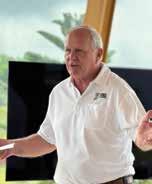

Product sourcing has become a crucial part of many companies’ commitments to sustainability, and more than 75 percent of Fortune’s Global 500 companies publish sustainability reports. Sourcing requirements focus on environmental and social issues and lead to positive impacts on business performance. These requirements apply to all types of raw materials, including U.S. Soy products.

The U.S. Soybean Export Council (USSEC) monitors the development of sourcing guidelines and requirements around the world and demonstrates how U.S. Soy complies. For example, the carbon footprint of soy is becoming increasingly important to international customers, as they use the data to calculate emissions. USSEC shows that U.S. Soy has the lowest carbon footprint compared to soy of other origins.
Soybean farmers in Indiana and throughout the U.S. demonstrate their long-term commitment to sustainability through the continuous improvements they are making in raising more with less. As the most recent Field to Market report shows, U.S. Soybean farmers have improved resource efficiency dramatically since 1980.
• 43 percent greenhouse gas emissions efficiency improvement per ton
• 46 percent energy use efficiency improvement per ton
• 48 percent land use efficiency improvement in acres per bushel
• 34 percent soil conservation improvement per acre
• 130 percent production increase in bushels per acre
The same report indicates that U.S. soybean farmers are making progress toward the industry goals put forward for 2025, using 2000 as a starting benchmark.
• Reduce land use impact by 10 percent (measured as acres per bushel)
• Reduce soil erosion by 25 percent (measured as tons per bushel)
• Increase energy use efficiency by 10 percent (measured as BTUs per bushel)
• Reduce total greenhouse gas emissions by 10 percent (measured as pounds of CO2-equivalent gasses emitted)
USSEC conveys these ongoing improvements to U.S. Soy customers around the world. The U.S. Soy Sustainability Assurance Protocol (SSAP) was created to provide credible information to give buyers of U.S. Soy confidence that the product they are purchasing is produced sustainably.
It uses national sustainability and conservation principles to aggregate U.S. Soy farmers’ contributions to improved environmental, social and economic sustainability outcomes.
The SSAP has been recognized by many third-party sourcing accreditations around the world, and use of this verification has been growing at an incredible rate.

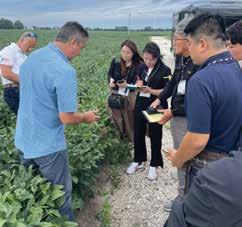
When the program began in 2014, less than 7,000 metric tons of exports carried SSAP verification.
In 2023, the U.S. exported nearly 44.5 million metric tons of SSAP-verified soy, which was 70 percent of all U.S. Soy exports. The percentage is likely similar for the roughly 1.8 million metric tons of soybeans exported from Indiana. This testifies to the success of the program and the growing market for sustainable U.S. Soy.
SSAP certificates can be transferred down the value chain up to four times, allowing many more users of U.S. Soy to show progress toward company environmental, social and governance (ESG) goals.

USSEC also works with customers around the world to use the Sustainable U.S. Soy logo. It takes assurance of sustainability from the SSAP a step farther by highlighting the use of sustainable soy in consumer-packaged goods.
Around the world, 93 companies use the label on about 1,000 products to identify they contain SSAP-verified soy. The new Fed with Sustainable U.S. Soy label now promotes products like poultry, pork or shrimp fed with SSAP-verified sustainable U.S. Soy in feed rations.
Beyond certificates and logos, USSEC shares the story of the sustainability of U.S. Soy in meetings, at conferences, via print and online advertising and more. When trade teams
visit farms, participants learn about sustainable practices directly from farmers.
For example, in August 2023, a team of soybean oil importers and refiners visited two Indiana farms, where they learned about crop rotation, cover crops, no-till and more. In September 2023, USSEC hosted nine European feed industry contacts for a tour focused on sustainability and sustainable soybean production.
It began with a visit to a site in Indiana operated by The Nature Conservancy, where 5,000 acres of former cropland has been restored to native prairie with the largest herd of bison east of the Mississippi River.
To learn more, check out the U.S. Soy Sustainability Assurance Protocol annual report, available at www.ussec.org.

Farmers representing the Indiana Soybean Alliance (ISA) recently traveled to Dubai to attend the world’s largest annual food, beverage and hospitality show. This year’s Gulfood Show took place on Feb. 19-23 and attracted more than 150,000 visitors and 5,500 exhibiting companies representing more than 190 countries.

ISA supports the USA Poultry and Egg Export Council’s (USAPEEC) ongoing efforts to increase U.S. poultry and egg exports at the Gulfood Show. The Middle East region represents an important market for those exports, which ultimately benefits corn and soybean growers.
ISA Board member Chris Eck, a farmer from Shelby County, said the event provided an opportunity to ensure that checkoff investments in the region are working.
“These are investment dollars that we’re putting in, and we need to make sure they’re being used properly,” he said. “We’re also finding out what the customers in the region want. For example, what kind of food do they want and how do they want their food processed and packaged. It’s worthwhile for us to attend as directors to see where checkoff investments are going and build relationships and make those contacts in person.”
During the Gulfood Show, Lucas and Eck visited ARAMTEC and talked with SAFCO, two major importers of poultry in the region and got to know more about the poultry and eggs market potential and challenges. Conversations emphasized how the United States can position itself as a provider of high-quality poultry products able to meet the needs of buyers around the globe.

“Something we heard over and over is that some U.S. products are not packaged exactly like they need to be for this market,” Eck said. “Other countries, like Brazil, are willing to make those processing changes. If we don’t change or start creating new markets, then we’re going to be blocked out of the export markets, and that’s not a position we want to be in.”
Lucas added that it will be important for U.S. suppliers to take customer preferences into account.
“There are some technical challenges depending on which region you’re speaking of, whether it’s halal or the packaging requirements for poultry or how some products are not necessarily accepted,” he said. “That’s something I’m taking away from this experience.”
Also attending was Matthew Lucas, a corn and soybean farmer from Jackson County, Ind., and an Indiana Corn Marketing Council board member.
“I think this is an excellent program to continue to fund,” he said. “It gives corn and soybean growers an opportunity to push our crops through exports of poultry products. It also gives us an opportunity to see what other countries want in terms of products that we offer.”
USAPEEC sees value in Gulfood Show, recognizes Indiana investment. USAPEEC President and CEO Greg Tyler said there were about $2.5 million in sales during last year’s Gulfood Show and an additional $7.5 million in sales following the event.
“We were looking at about $10 million in sales from the 2023 Gulfood Show,” he reported. “There were also 160 trade leads that came in during that time, promoting
long-term development of new trade contacts. The Gulfood Show is important to us as we have buyers from Africa, the Middle East, and Europe as well as India and Asia.”
Increased trade and exports of U.S. poultry and eggs benefit U.S. soybean growers.
“The more we export U.S. poultry and eggs, the more demand there is going to be for production in the U.S., and, of course, that means that we’re going to need more soybean meal to feed all the chickens, turkeys and ducks we have,” Tyler explained.
Tyler said the support from Indiana’s soybean checkoff doesn’t go unnoticed. “Without it, we couldn’t do this show or a lot of the programs we do around the globe,” he said. “It’s a great partnership we have with Indiana, and we want to thank you from the bottom of our hearts for your support in expanding exports of U.S. poultry and eggs.”
The project helps to increase U.S. broiler and turkey exports worldwide through participation and expanded presence at the Gulfood Show. It focuses on growing exports to the Middle East region as well as surrounding markets that are reached in one central location such as Sub-Saharan Africa, North Africa, India, Asia and Central Asia.
The United Arab Emirates (UAE) is the top export market for U.S. poultry products in the Middle East, according to USAPEEC. In 2023, the U.S. exported more than 62,000 metric tons of chicken broiler meat, nearly 750 metric tons of turkey meat, and 125 metric tons of other poultry meat to the UAE.
With Indiana ranking No. 1 in commercial duck production and No. 3 in egg and turkey production, it’s important to maintain these markets and support the exports of these products.
The trade show floor also provided the opportunity to discuss the benefits of high oleic soybean oil.
Eck grows high oleic soybeans on his farm. He spoke with exhibiting companies about the longer fry life and improved fat-profile of high oleic soybean oil.
“We found multiple companies that use high oleic soybean oil in their fry oils and had conversations with them about what they’re looking for and how there are customers asking for the product,” he said. “High oleic soybean oil extends a products’ shelf life and offers a longer fry life. We were able to express to them that if you extend the life, you save money. We also talked about the benefits of being heart healthy and not transferring flavors.”
Both Lucas and Eck encourage farmers to travel and see projects firsthand when given the opportunity.
“You get a real perspective of the world economy that we’re dealing with,” Eck said. “Even if you’re only selling at home, the prices are based off of a world economy and if you don’t come and see your customers, they’re not going to be your customers long.”
Lucas added, “This is a great opportunity to be the boots on the ground and see what we’re doing with our checkoff investments. It also gives us an opportunity to go back home and explain to farmers in our area what we’re achieving and tell our story.”


The Gulfood Show trade show floor also provided the opportunity to discuss the benefits of high oleic soybean oil. Ed Ebert, ISA’s senior director of market development, and Eck and Lucas discussed the longer fry life and improved fat-profile of high oleic soybean oil.
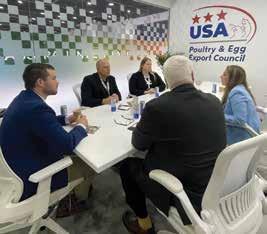
Every year the U.S. Meat Export Federation (USMEF) commissions an independent study by Dave Juday of the Juday Group to quantify of the impact U.S. beef and pork exports have on corn and soybeans. The topline numbers reflect the continuing story of the importance of red meat exports to growing demand for U.S. corn and soy.

In 2023, beef and pork exports accounted for the consumption of 512.7 million bushels of corn with a value of more than $3 billion. Those exports generated about 87 cents of the per-bushel value of corn, or about 14.6 percent. The contribution to the value of U.S. DDGs was about $672 million.
The story is equally strong when it comes to pork exports and the value of soybeans. Pork exports accounted for 96.8 million bushels of soybean consumption, contributing 13.86 percent of the perbushel value, or $1.95 per bushel. That adds up to a total economic impact for soybeans of more than $8 billion in 2023.
Drilling down to Indiana specifically, red meat exports consumed 36 million bushels of the state’s corn, adding $934 million in value to Indiana’s corn crop. Pork and beef exports in 2023 required 177,458 acres of corn production in Indiana.
Nearly 8 million bushels of Indiana soybeans were used by pork exports, adding a total value of $652 million and accounting for 127,418 acres of production.
But that’s just one side of the story. While U.S. beef and pork exports are key vehicles for expanding corn and soybean usage, this
relationship also plays a vital role in expanding the exports of U.S. red meat.
Sustainability has become an increasingly important part of the story for consumers around the globe, and no one has a stronger sustainability story than U.S. corn and soybean growers. It’s a key component of the global marketing message for U.S. red meat that was recently highlighted by USMEF Chair Randy Spronk, a pork and grain producer from Edgerton, Minn., at Commodity Classic in Houston.
“We talk about how we differentiate our product in the international market, and I think the story that we have about how we raise our soybeans, how we raise our corn, how we process the feed, and the efficiencies –that’s a story that differentiates us from other exporting countries,” Spronk explained.
“When I graduated in 1981, 100-bushel corn was the max yield. You look at it today, it’s two-and-a-half times that. There is no greater efficiency and sustainability story than that – producing more with less. That’s a story that differentiates our product when it comes to feedgrains.”
Buyers around the world understand that quality feed is what drives high-quality protein products from the United States, and it’s the strong partnerships with growers and their organizations that enables USMEF to convey this quality and sustainability story to global consumers.

It’s a partnership that continues to pay off. Since 2015, corn consumption attributed to red meat exports has grown from 356 million bushels to 513 million bushels. Since 2018, soybean consumption attributed to red meat exports has climbed from 84.2 million bushels to 96.8 million bushels. We’re working together to move the pile.

Whether shipping by river, road or rail, the soy checkoff is committed to ensuring America’s infrastructure is a significant advantage for U.S. soybean farmers. We’re looking inside the bean, beyond the bushel and around the world to keep preference for U.S. soy strong. And it’s helping make a valuable impact for soybean farmers like you.
See more ways the soy checkoff is maximizing profit opportunities for soybean farmers at unitedsoybean.org
The Indiana Corn Marketing Council (ICMC) is committed to promoting and making higher-ethanol fuel blends available for consumers in Indiana.
Through checkoff investments, ICMC works with retailers to promote infrastructure updates to include these higher blends of ethanol. ICMC and Valparaiso, Ind.-based retailer Family Express have been working together for more than a decade.
In a visit to Family Express in early February, Family Express President and CEO Gus Olympidis told ICMC about the company’s expansion and continued support of renewable fuels, the agriculture industry, and Indiana farmers.
Family Express is expanding its footprint and updating its colonial style with a contemporary look to appeal to a younger demographic. The retailer is building up to 20 new convenience stores, serviced by its central distribution facility. The company has been adding car washes and with an enhanced focus on food service, it has been adding kitchens to many stores.
Olympidis said the company is in a good position for expansion.
According to its company history, Family Express strives to deliver a unique customer experience by building relationships with its customers and its communities. The company’s vertically integrated business model is crowned by its “Living Brand.” Family Express will often assess 50 prospects before it hires the one person that is ideal for serving its customers.

“Family Express has been debt free for a number of years in an industry that is remarkably capital intensive,” he said. “We have made a strategic decision to grow, and you’re going to see it unfolding in the next few months. We’re building our land bank, closing on sites and tweaking our prototype.
“It was a difficult thing for us to let the classical colonial look go. It defined us for about 30 years. It was the anti-convenience store look and looked more like a bank. It helped solidify the image that we have in the marketplace as a convenience store that also sells fuel.”
Family Express operates convenience stores in northwest and central Indiana. Olympidis said Family Express is exploring acquisition opportunities.
Family Express is an early adopter and advocate for higher blends of ethanol, offering E85 Flex Fuel, a blend of 85 percent ethanol and 15 percent gasoline, and Unleaded 88, a blend of 15 percent ethanol with 85 percent gasoline, at some locations.
Olympidis says the company will continue to offer renewable fuels because they make sense.
“Why does corn-based ethanol make sense for Family Express? There is a great supply of corn in Indiana and (ethanol) is renewable and good for the environment,” Olympidis explained. “Why wouldn’t we promote a renewable product produced domestically, specifically in our geography in the Midwest, which supports farmers?
“We believe biofuels should be part of our future and we will promote it to the extent that we can. Through the expansion we’re going to incorporate biofuels wherever we can and make them available to the consumer.”
Olympidis said there is an opportunity for ICMC and its farmer members to highlight the environmental benefits of ethanol, which contributes up to a 50 percent reduction in greenhouse gas emissions compared to petroleum.
“There’s a big issue right now with legitimate environmentalism and pseudo environmentalism,” he said. “Biofuels are an example of true environmentalism. You
don’t need to buy a different vehicle or install anything in your garage to make an immediate impact on the environment. You can be a good steward of the environment today by selecting the correct nozzle that has biofuels.”
He cites electric cars as an example of pseudo environmentalism for being touted as a quick climate solution because they can take several years to reach carbon neutral.
“You’re behind the eight-ball at that point, and the assumption is after about nine years you’re going to start helping the environment. That doesn’t make sense,” Olympidis said. “Some other questions to answer are: Where are the batteries going to go? Where is the electricity going to come from? And, how much coal is going to be consumed to produce the electricity at the charging station?
“Family Express is very interested in electric vehicles, and I’ve been an advocate for them for the last 25 years in applications that make sense. In terms of making an immediate impact, they’re not there, yet.”
He said there is a significant opportunity for farmers, agriculture and the biofuels industry.
ICMC continues to work with retailer partners to promote ethanol and build demand for Indiana corn.
ICMC Biofuels Director Helena Jette has worked directly with Family Express for nearly six years and welcomes the new look and expansions coming soon.

During a meeting, Gus Olympidis, Family Express President and CEO, told ICMC about the company’s expansion and continued support of renewable fuels, the agriculture industry and Indiana farmers.
“I have enjoyed working with the entire Family Express team and appreciate their consistency in supporting and utilizing biofuels. They lead by example,” Jette explained. “I am looking forward to new collaborations in 2024 and beyond.”
Family Express markets E85 in nearly 30 retail outlets.
As of now, there are 93 E15 and 288 E85 fuel retail stations in Indiana – a 9 percent increase from the previous year. Since the inception of the Indiana checkoff program in 2007, ethanol production has increased by 1.3 billion gallons, which is equivalent to 520 million bushels of corn, according to ICMC’s 2023 annual report.
The U.S. Grains Council (USGC) hosted a series of promotional events around the world in January in support of its 2023-24 Corn Harvest Quality Report, published annually in November. The report contains detailed physical and chemical analysis of U.S.-grown corn to international shippers and buyers.
O’Connor of the Minnesota Corn Research and Promotion Council gave attendees insights into this year’s crop from his experiences in the field. A global grain market outlook and presentation on the USGC’s Corn Sustainability Assurance Protocol (CSAP) wrapped up the event.
The first of these events was conducted by USGC staff in China, who organized a corn quality roadshow and seminar in Beijing and Guangdong Province to discuss the results of the report and inform attendees about other critical topics relevant to the country – one of U.S. agriculture’s largest markets.
Outside the seminar, the Council’s team had the opportunity to meet one-onone with several major manufacturing companies to identify their material requirements for the future.

Later that month in Malta, USGC’s Europe, Middle East and Africa (EMEA) regional office hosted its 13th annual rollout event that drew 75 attendees from Morocco, Tunisia, Egypt, Jordan, Saudi Arabia, Turkey, United Kingdom, Belgium, France, Switzerland, S pain, United Arab Emirates, Oman, Lebanon, Ivory Coast, Senegal, Kenya and Nigeria.
Elsewhere in Asia, USGC staff hosted corn quality report rollout events in Japan, South Korea and Taiwan. While many of the CQRs follow a similar agenda, each is tailored to the specific market in which it is taking place to best meet the needs of customers there.
In Taiwan and Japan, attendees were presented with the results of the report in addition to hearing from two U.S. corn farmers and USGC Vice President Cary Sifferath, who gave updates on the global supply chain before question-andanswer panels took place at both events.
“Attendees in Taiwan expressed their gratitude that the Council provided insight on logistical issues and the possible ways to combat those,” said Michael Lu, USGC director in Taiwan. “They were also impressed by the precision farming techniques U.S. corn producers used to reach high efficiency of production and environmental protection.”
Potential buyers in Korea were also given the chance to hear more about the high quality of the 2023 U.S. corn crop during the event in Seoul. USGC At-Large Director Jim
The seminar also covered several trade and technical topics, including global and U.S. feed grains supply and demand, global freight trends and Suez Canal logistics challenges, corn co-products cost availability and nutritional value in feed formulations, and a presentation on the starch and storage USGC programs in the region.
The event included one-on-one meetings with key importer companies to further promote the quality and value of U.S. corn and corn co-products. These meetings resulted in negotiations of more than 110,000 metric tons (4,330,480 bushels) of corn and corn co-products set to enter the region.
“Every year, the Council organizes quality rollouts to disseminate information at two critical points in the corn marketing year – at harvest and at time of export. The information shared was very useful for all stakeholders to not only glean information about current crop conditions and quality, which then translates to purchasing decisions, but also in allowing USGC to showcase the value, transparency and integrity of the U.S. corn export market from the farm through the marketing system,” said Ramy H. Taieb, USGC EMEA regional director.
One weather event in 2007 completely changed the course of a farming operation in west central Indiana. Rick Clark, a fifth-generation farmer in Warren County, describes a soil erosion event after a one-inch rainfall as a wake-up call.
“We did our normal tillage one day in the spring that year before we had a one-inch rain event,” Clark explained. “That evening, I was driving down the road and slowed down because something was in the road. I soon realized it was soil from our fields. That’s when I said, ‘it’s time to make a change.’ That’s what got us started down the regenerative agriculture road.”

current rotation includes corn, soybeans, wheat, alfalfa, peas, milo, cover crops, cattle and sheep.
Clark said he’s seen the benefits of going from traditional tillage 17 years ago to 100 percent no-till to 100 percent cover crops to 100 percent non-GMO, and now, 100 percent organic. But it’s been a process, he said. Before beginning to transition to organic in 2017, Clark said the operation was the most profitable when the farm was 100 percent nonGMO, 100 percent cover crop, and 100 percent no-till with a 70 percent reduction of fertilizers and pesticides.
“We had the biggest return on investment the farm has ever seen at that time,” he said.
He began researching cover crops and no-till because of the soil erosion event. Clark decided to start with tillage radish, because it has a deep tap root, pulls nutrients to the surface, mitigates compaction, and is a winter-kill cover crop that doesn’t need to be terminated in the spring.
During that planting season, Clark took a 200-acre field and used his typical tillage practices on half and switched to no till into the radish cover crop on the other half.
“At harvest, it was the best yielding field on the farm and the best return on investment. I saw the power of cover crops and started working to get them on acres across the farm right away,” he said. “From there, we started implementing cereal rye cocktails with up to four or five cover crop species in addition to 100 percent no-till. Mother Nature has absolutely guided me where to go, because if that weather storm hadn’t happened that night and moved the field to the road, we may not be here today.”
Today, the farm is 100 percent organic. Clark has been able to incorporate regenerative farming practices like crop rotation, no-till, cover crops and elimination of fertilizer and pesticides with all acres being certified organic. The family’s
When we first transitioned to organic production there was a 30 percent drop in yield that was balanced by higher crop prices and lower input costs. He transitioned 500 acres to organic in the first year and was 100 percent organic four years later.
“Today we are saving about $500 an acre in input costs. For a farm of our size, it’s getting close to $3 million of input savings per year,” he said. “When you look at our system, you begin to understand that I’m not about yield. I’m about

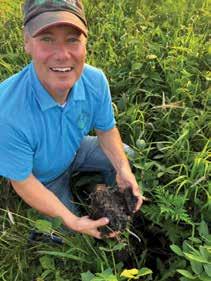
saving money on the front end and minimizing risk and then the yield will come on the back end. I don’t need a lot of yield, because not only are we taking inputs to zero, I’m on organic price levels which are double conventional corn and soybean prices. If you want to increase your yield, don’t follow what we’re doing because this is about building soil health, building human health, being a good steward of the land and being conservation-minded.”
He said concerns about weeds shouldn’t prevent someone from trying organic production.
“The best way we know to mitigate weeds in an organic system is through cover crop suppression,” Clark said. “We raise cereal rye and are planting soybeans in the cereal rye at the boot stage. We roll it all down at anthesis, and the soybeans come back up and the rye stays down. You’ve now laid a mat down that covers the ground and armors the soil.
“The timing of planting cover crops in the fall also impacts weeds. Cover crops planted in September, for example, may have 40 percent more biomass, and it’s going to hold the weeds back longer than cover crops planted in November. The success of next year’s cash crop starts with the success of this year’s cover crop.”
Advice he has for farmers considering implementing or ramping up conservation efforts is to start small and be prepared to give the practice some time before expecting results.
“This is a minimum of a five-year journey to even think about reducing inputs,” Clark said. “My first piece of advice is not to jeopardize the livelihood of the farm. My second piece of advice is to do something that has a high likelihood of success the first time you try it because if it doesn’t work, you’re not going to want to do it again. My third piece of advice is not to offend the practices that are currently in place on the farm because this is heritage. This is the way your dad has done it; this is the way your grandfather has done it. The last thing you want to do is walk in and upset anyone and get them on the defense. It’s all about working together and taking a couple of ideas and bringing those
ideas to your farm on a small scale to see how it works.”
Clark said implementing practices to improve soil health can and must be done because the next generation will be impacted if soil degradation continues. His hope is that a farmer interested in improving soil health will take two or three practices and implement them on his or her own farm and give it two or three years before expanding to additional acres.
He encourages farmers to step out of their comfort zone and try something different.
“If you’re not uncomfortable with what you’re doing, then you’re not trying hard enough to change,” Clark said. “I challenge everyone to get a little uncomfortable. I think you’ll like how it feels.”
He encourages farmers looking for resources to reach out to their local Purdue Extension. He also suggests finding other farmers who are already implementing some of these practices.
Farmers interested in implementing some conservation practices can contact Joe Rorick, the on-farm sustainability programs and research coordinator with the Indiana Soybean Alliance, at jrorick@indianasoybean.com.

One weather event in 2007 completely changed the course of Clark’s farm. After seeing topsoil washed across the road, he adopted farming practices to build soil health and protect the environment with no till cover crop methods and more.



Many researchers across the country are working on behalf of farmers to find solutions to the issues created by soybean cyst nematode (SCN). Agronomists are exploring field management practices such as crop rotations and cover crops to reduce the spread of SCN. Geneticists and breeders are developing new soybean varieties with SCN resistance in their genetic makeup. Others are supporting both aspects of research to aid in genetic development and reduce in-field populations.
Lei Zhang, an assistant professor of botany and plant nematology at Purdue University, is leading a research project that could benefit scientists and farmers. The project, supported by the Indiana Soybean Alliance (ISA), focuses on SCN hatch potential through nematode genetics.

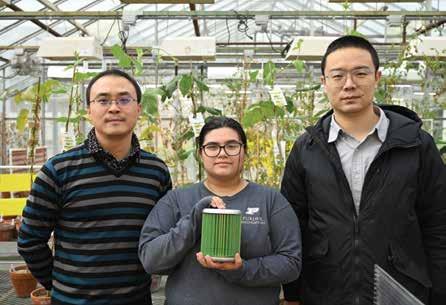
“With this project, we are looking at molecular markers that can determine how well SCN eggs will hatch. We want to eventually develop an on-farm tool that can identify SCN population density and hatch potential,” Zhang said. “We have identified candidate SCN genes through RNA-sequencing that may be good indicators for higher or lower egg hatch potential. We have been conducting tests in the lab and in greenhouse conditions for confirmation.”
Some crops, such as dry beans and a few cover crops
including clover and hairy vetch, are SCN hosts. Other crops are considered non-host crops for this pest. Non-host crop rotation is a way to control SCN. When the SCN eggs hatch into a non-host crop, there isn’t food available for them, so the nematodes die and their populations decline in the soil. However, if SCN egg numbers are high at the end of the soybean growing season, a rotation with a non-host crop may not effectively reduce SCN populations, says Zhang. SCN eggs can remain dormant and viable in the soil for several seasons and when soybeans are grown in the field again, the SCN eggs sense the presence of soybean roots and hatch to infect the plant. By finding a way to evaluate SCN egg hatch potential, farmers can use this information to make field-level decisions.
“For example, if farmers have an idea that the potential of SCN hatch is high, then planting a non-host crop will be crucial and effective to help reduce SCN population density. With this information, farmers can be cognizant of planting a nonhost crop, such as corn, and not another host crop within their rotation,” he explained. “Of course, environmental conditions, such as soil moisture and temperature, can affect hatch potential, as it can be variable among different years and different fields.”
Currently, finding SCN hatch potential through a hatch assay in a lab takes up to three weeks and is labor-
“We want to develop a tool that is portable, that can be used in the field. A retail agronomist or extension specialist could conduct the test through soil sampling and have diagnostics completed within a day or sooner.”
intensive, and therefore costly. Locating molecular markers within the nematode genes can help to speed up this lengthy process, determining the potential in a day or less. This could be good news for fellow researchers as well as farmers.
“We want to develop a tool that is portable, that can be used in the field,” Zhang said. “A retail agronomist or extension specialist could conduct the test through soil sampling and have diagnostics completed within a day or sooner.”
The portable machine Zhang is working on uses polymerase chain reaction, or PCR, technology to test soil samples in the field for SCN population density and hatch potential. This technology may sound familiar, as it is used when testing for the COVID-19 virus in humans.
But first, Zhang needs to ensure the SCN hatch potential genetic markers and genes associated with SCN hatch are accurate. The team ran the newly developed diagnostic analysis on SCN samples in the lab, then on SCN propagated in their greenhouse.
They compared results with traditional methods of evaluating SCN hatch potential with positive outcomes. This coming crop season, Zhang will expand the testing of both the genetic markers and the portable machine in research plots under real growing conditions.
Zhang said the on-farm diagnostic test can be done similarly to traditional SCN testing. Before planting or after harvest are appropriate times to take soil samples for both detection of SCN in the field and for his SCN hatch potential test. Making this technology available to find out hatch potential quicker and for less cost can provide answers for farmers and crop consultants to help make field-level management decisions.
“By doing this diagnosis, it can provide an estimate of the abundance and hatch potential of soybean cyst nematode in the field,” Zhang said. “Growers can compare this with their threshold numbers to help decide what should be grown in rotation in each of their fields.”


Green initiatives should not add red to the balance sheet. At ADS, better for the environment means better for business. That’s why we‘ve worked diligently to engineer recycled products and innovative water management solutions to improve yields and keep families farming for generations.

our commitment to sustainability is always worth the work.
Sulfur (S) is a macro-nutrient that is needed in large quantities for all crops – including soybeand.
Soybeand take up .35 pounds of S per bushel, so 50- to 75-bushel soybeans would need 17.5 to 26 pounds of S per acre. A little more than half of this S is removed in the grain – largely in amino acids of the protein – thus 9 to 13.5 pounds of S per acre is removed from the field in the grain.
Soybeans have an additional need for S that is not present in corn and wheat. Sulfur is needed as a co-factor for root-nodule formation by Bradyrhizobium japonicum (see Figure 1). A limited S supply can restrict biological nitrogen (N) fixation of soybean.

This combination of a low supply of S and N, via poor nodulation, can restrict the yield from 5- to 20-bushels per acre, and the quality of soybean grain (i.e., protein) in many fields.
Atmospheric deposition of S, mineralization of organic matter and plant residue, and fertilizer applications are the primary sources of S. In Indiana, annual atmospheric deposition has declined from nearly 20 pounds of S per acre in the 2000s to now less than 5 pounds of S per acre. Coarse-textured soils with low organic matter (less than 2 percent) have traditionally been more deficient in S than heavy-textured soils with more organic matter.
Approximately 3 pounds of S per acre is mineralized annually for every percentage point of soil organic matter. Thus, a soil with 3 percent organic matter would have about 9 pounds of S per acre mineralized plus 4 pounds of S per acre deposited from the atmosphere to total 13 pounds of S per acre, which is still half of the 26 pounds of S taken up by a 75-bushel soybean crop.
This back-of-the-envelope calculation does not mean every field needs S fertilizer applied, but it certainly should raise awareness for you to test for yourself. Current soil nutrient analyses can provide S concentration, but the correlation to crop need and yield response is unreliable
due to the timing of the soil analyses and the mobility of S in the soil. Sulfate movement is somewhat similar to nitrate leaching.
Leaf nutrient analyses of the most recent mature leaf can provide a snapshot that S may be an issue when concentrations are below .25 percent S or “close” to it. Another indicator of S issues is the ratio of N to S in the leaf tissue. As this level approaches and exceeds 18:1 (18 parts N to 1 part S), soybeans will be more responsive to S application. Ultimately, we need to allow soybeans to be the S integrator of atmospheric deposition, soil supply and management interactions.
We have documented sizable yield gain, 7- to 22-bushels per acre, improvement in leaf nutrition and positive plant growth responses (e.g., nodulation and N fixation, leaf retention, seed protein) following targeted S fertilizer applications. Soybean responsiveness to S applications can be categorized into true S deficiency and situationally deficient in S.
The first category of true S deficiency is based on the soil supply and lack of deposition (i.e., the traditional fields that are coarse-textured with low organic matter). Soybeans in these fields are the ones that respond to S year in and year out no matter the production practices. The second category is where the soybeans are situationally deficient in S based on the combinations of field characteristics and management such as planting date, tillage and cover crop inclusion.
Timely planting of soybeans has provided solid foundations in high yields. In fact, Indiana has repeatedly broken state record yields in 2018, 2020, 2021 and 2023 as the planting progress was earlier than the 5-year average. Indiana’s planting of soybean crops has shifted from approximately 14 days after corn from 2010 to 2017 to approximately five days in 2018to 2021. Now it is usually within1.5 days of corn.
Many farmers are even planting soybeans ahead



The Soybean crops on the left were not treated with S. The leaves contained .27 percent S with an N:S ratio of 18:1. The soybeans on the right were treated with 20 pounds of S per acre from AMS. The leaves of these plants contained 38 percent of S with N:S ratio of 15:1. These photos were taken July 15, 2016, near LaCrosse, Ind.
of corn. Soybeans often sit in the ground for weeks on end due to cool and sometimes wet conditions. These cool conditions, approximately 50-degrees F., also slow microbial activity. As a result, mineralization of organic matter and breakdown of plant residue to supply N and S.
The limited mineralization has provided challenges, but also opportunities to overcome and be even more productive. As an example, my timely planting of soybeans on a prairie soil, approximately 4 percent organic matter, has averaged an 8- to 11-bushels per acre response to S fertilizer (e.g., ammonium sulfate, pelletized gypsum, ammonium thiosulfate) applied PRE at 20 pounds of S per acre during a 5-year period.
Conversely, soybeans planted later in the same soil that was warmer did not respond to S fertilizer.
The situational response to S was even more dramatic in 2023. Soybeans planted on April 18 went from 77- to 99-bushels per acre with the addition of ammonium sulfate or pelletized gypsum (see Figure 3). A May 12 planting displayed a similar response from 75- to 90-bushels per acre, but the June 7 planting displayed no benefit of S fertilizer.
If you have not explored S on your soybean crops, I suggest applying strips of S fertilizer that is soluble (e.g., ammonium sulfate, pelletized gypsum, ammonium thiosulfate) between 15- to 25-pounds of S per arec to determine if you have fields or production practices that are responsive to boosting nodulation and N fixation. Applications can be applied mid-March through planting with higher rates the earlier you apply the S fertilizer.

April 18, 2023, on prairie soil – 3.8 percent organic matter.
on the left averaged 77 bushels per acre with no sulfur added. The soybean crops on the right averaged 99 bushels per acre with 20 pounds of S per acre applied prior to emergence. Ammonium sulfate and pelletized gypsum were two soluble sources of sulfur that demonstrated the same soybean response. This photo was taken on Aug 30, 2023, near West Lafayette, Ind.
Editor’s note: The content of this column was not published in the January edition of the Indiana Corn & Soybean Post as it was intended. This column is being re-published in this issue.
Lately, several prominent agricultural seed and genetic companies have started introducing novel corn hybrids characterized as “short-stature.” These hybrids are noticeably shorter than current “full-stature” hybrids and can often range 20-24 inches shorter in height (Figure 1)

Overall, these hybrids have potential benefits which include increased lodging resistance, increased tolerance to higher plant populations, and narrower rows, and easier in-season access with spray equipment for fertilizer and pesticide applications. However, the introduction of these new hybrids raises many new questions for producers and consultants, such as:
• How do these hybrids compare to current fullstature hybrids?
• How well do these hybrids yield?
• Do these hybrids require higher optimum seeding rates?
• How challenging are these hybrids to harvest?
Therefore, new 2023 research at Purdue University in partnership with Bayer CropScience, one of the leaders in the introduction of these new hybrids, sought to answer some of these questions.
In 2023, research trials at Purdue University comparing both short-stature and full-stature hybrids observed noticeable differences in both average plant height (67 inches versus 86 inches) and average ear height (22 inches versus 37 inches, measured from the point where the ear shank attaches to the main stem), yet minimal
differences in average above-ground total plant biomass (7,300 versus 7,200 pounds per acre) at the R1 growth stage. The reduced heights of short-stature hybrids are typically realized in the “stacked” internode-spacing below the ear (Figure 2).
In addition, short-stature hybrids maintained similar leaf number and exhibited a wider stem diameter and a wider ear leaf diameter than full-stature hybrids, likely contributing to the lack of total biomass differences. Overall, these short-stature hybrids maintained very strong yields at both of the Purdue research locations in Indiana and produced the same or slightly lower yields in comparison to full-stature hybrids when grown in the exact same environments.
For example, short-stature hybrid yields did exceed 300 bushels per acre within multiple research treatments and maintained average yields ranging from 240-260 bushels per acre in northwest Indiana and 250-300 bushels per acre in central Indiana.
These hybrids also exhibited a higher tolerance to both increased seeding rates and narrow row (20inch) systems. For example, research in both central and northwest Indiana observed continued grain yield increases as seeding rates increased from 34,000 to 50,000 seeds per acre when grown in 20-inch rows, which suggests these hybrids may have the potential to tolerate even higher plant populations when grown in narrow row systems.
Furthermore, agronomic optimum seeding rates for short-stature corn in 30-inch rows were often on average 6,000-8,000 seeds per acre more than current full-stature hybrids. Overall, these hybrids show tremendous promise in their ability to yield well and tolerate higher plant populations and narrower


rows, however, many physiological and management questions remain and will continue to be pursued.
One of the biggest challenges these hybrids will continue to face will be both ear height and harvestability. Corn ear position on the main stem must maintain specific heights above the soil surface in order to be properly harvested by current combine headers and to avoid any added additional wear on machines. For example, 2023 research at Purdue observed a fairly strong relationship between ear height and yield once the height dropped below 23-24 inches, whereas the relationship to yield became much weaker when ear height was above this threshold (Figure 3).
Based on 2023 research at Purdue, corn ear height was dictated by hybrid selection, planting date, growing season environmental conditions, and management practices, meaning each of these factors will remain important when adopting short-stature hybrids.
Overall, these hybrids showcase the potential to
improve U.S. corn production, improve resiliency to adverse weather conditions, and improve the ease and efficiency of in-season nutrient and crop protection applications. However, many questions persist, and further research will be required to fully understand this new corn hybrid system.
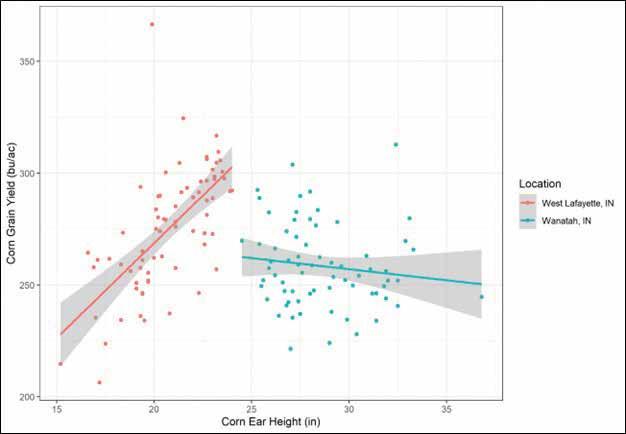
All professional basketball players are gifted with special skill sets that separate them from the rest of us who try to shoot baskets in our driveways. Only elite players, though, are selected to play in the National Basketball Association’s All-Star Game, which was on Feb. 18 in Indianapolis this year.

Similarly, Indiana-grown soybeans are a versatile commodity among the crops produced by Hoosier farmers. But growers high oleic soybeans are finding that increased attention comes with a premium. Getting a chance to shine during the NBA All-Star Weekend was soybean oil made from high oleic soybeans. The Indiana Soybean Alliance (ISA), the state’s soybean checkoff program, promotes the benefits of high oleic soybean oil to farmers and consumers.
Thousands of basketball fans flocked to Gainbridge Fieldhouse for the NBA All-Star Game festivities during the weekend of Feb. 1618. Gainbridge Fieldhouse is the home to the NBA’s Indiana Pacers. For more than a year, the Pacers and its concessions supplier, Levy Restaurants, have agreed to use high oleic soybean oil in food preparation for events at Gainbridge Fieldhouse.
show the state’s soybean farmers the value their checkoff brings.”
Michael Lake, senior sales director of corporate partnerships for Pacers Sports & Entertainment, agreed that partnership with ISA has been mutually beneficial.
“We at Pacers Sports & Entertainment pride ourselves on looking for partners that we can set up relationships that are win-win, and this is truly that in every sense,” he said. “To work with and use an amazing product that is grow in Indiana and even parts of the county we call home is so great.”

The Indiana Soybean Alliance logo and the slogan “We Grow Soybeans” are prominently displayed throughout Gainbridge Fieldhouse, the NBA home of the Indiana Pacers. All concessions at Gainbridge Fieldhouse are using high oleic soybean oil for foods served at events.
In return, ISA bought sponsorship – including the slogan “We Grow Soybeans” – on the Pacers’ playing floor. In addition, ISA has informational signage about the benefits of high oleic soybean oil and the farmers who grow it near the arena’s concession stands. High oleic soybeans are sustainably grown in Indiana on family-owned soybean farms and transformed into soybean oil at three facilities located around the state.
“This is a great opportunity to showcase a product grown here in Indiana,” said ISA Chair Kevin Cox, a farmer from Brazil, Ind. “High oleic soybean oil is a healthy and nutritious alternative to traditional vegetable oils. I couldn’t be prouder as an Indiana farmer to promote this success story, and to
Lake said more than 600 jugs, or 21,000 pounds, of high oleic soybean oil will be used at Gainbridge Fieldhouse during a typical season. He is pleased that the NBA All-Star Game and festivities present an opportunity.
“We are ready to showcase our city and state to the world,” Lake explained. “To work with the Indiana soybean farmers, and to have them in action in our building, is so fitting.”
High oleic soybean oil is a new vegetable oil that lasts longer for food preparation at restaurants–making it more economical. Lake said both customers and vendors are pleased with the oil. “The performance is great,” he said. “We have noticed that the oil lasts longer than other oils. This oil leaves a great color and helps to enhance the food flavors.”
More high oleic soybeans are grown in Indiana than anywhere else on Earth. ISA is committed to expanding use of this oil, in part, because farmers receive a premium for the crop.
In 2023, Indiana farmers planted approximately 850,000 acres of high oleic soybeans resulting in more than $100 million in premiums being paid back to farmers.
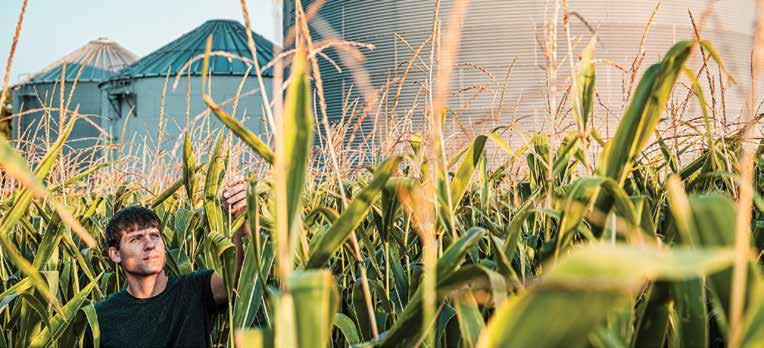
Petition now to serve on the Board of Directors of the Indiana Corn Marketing Council.
The Indiana Corn Marketing Council (ICMC) is seeking Indiana corn farmers interested in serving on its board of directors. The ICMC manages corn checkoff investments and determines promotional, educational and research activities to strengthen Indiana’s corn industry.
The ICMC board includes 17 voting farmer-directors. Five seats - in Districts 2, 5, 8 and two At-Large - will be filled through the ICMC’s annual elections in August 2024.
• District 2. One seat up for election – The counties of Elkhart, St. Joseph, Marshall, Kosciusko, Fulton, Wabash, Miami, Cass and Carroll.
• District 5. One seat up for election – The counties of Grant, Howard, Tipton, Clinton, Madison, Hamilton, Boone, Hancock, Marion, Hendricks, Morgan, Johnson, Shelby, Rush, Bartholomew and Decatur.
• District 8. One seat up for election – The counties of Monroe, Brown, Jackson, Lawrence, Orange, Washington, Crawford, Harrison, Floyd and Perry.
• At Large. Two seats up for election to represent the entire state of Indiana.
Candidates for the ICMC board of directors are required to be registered voters, at least 18 years of age, corn farmers in Indiana, and have an assessment on corn during the previous two years. Applicants must fill out and sign a petition form. It is available at County Extension offices, at www.incornandsoy.org/icmcelection, or by calling the Indiana Corn office at 317-644-2863.
Petitions must be returned to the ICMC office and postmarked before June 1, 2024.

Represent your district.

This is an exciting time to become more involved with a dynamic organization as the Indiana Corn Marketing Council continues to move forward to responsibly invest state checkoff in programs that will improve the bottom line for Indiana corn farmers. The focus going forward will be on Market Development, Value Creation, Sustainability and Producer Engagement.
The Indiana Soybean Alliance (ISA) has partnered with Cutting Edge Curriculum to teach agriculture to middle school students. Cutting Edge Curriculum is a not-for-profit corporation created by agricultural education advocates with a focus on curriculum development for Career and Technical Education (CTE) including Ag Education, Business, Family and Consumer Sciences, Health and Industrial Technology.

educators to access a sophisticated curriculum system. Educators, especially agricultural educators, have many responsibilities. Providing additional tools through a paid subscription not only allows for teachers to feel appreciated but provides them with an inquiry-based lessons to strengthen student knowledge.
Kocher said the curriculum is receiving rave reviews from Hoosier teachers.
Cutting Edge Curriculum houses the MYCAERT system to provide this curriculum to teachers and students through an online subscription. The MYCAERT system delivers educators with lesson plans and support materials, signature E-Units for student use, and web-based assessments aligned to academic standards. ISA provided free subscriptions to this curriculum and online tools to students and teachers.
“Cutting Edge Curriculum greatly appreciates the partnership with Indiana Soybean Alliance to offer all Indiana agricultural educators with access to the Middle School Agriscience curriculum,” said Lindi Kocher, executive director of Cutting Edge Curriculum.
The middle school agriscience curriculum is designed to provide Indiana agricultural educators with the essential tools to stimulate student interest in the field of agriculture. The lessons use an inquiry-based format known as a 5E lesson plan. Each lesson encompasses the following: Engage, Explore, Explain, Elaborate and Evaluate.

Stacey Hartley has been a teacher at Tipton High School for 22 years. “MYCAERT is awesome,” she said. “It provides a reading opportunity. It provides pacing, and it provides the activities from start to finish. The whole lesson is there, and it covers the whole scope of concepts within the intro class. The 5E process has really made me think about my other classes, and how I approached that curriculum.”
Lindi Kocher, executive director of Cutting Edge Curriculum, speaks to a group of Indiana ag educators about middle school curriculum that is made available for free to schools across Indiana through sponsorship by the Indiana Soybean Alliance.
Within a 5E lesson, there are multiple student activities supporting inquiry-based instruction. This approach provides effective strategies while students learn to conduct investigations and dig further into a topic. Lessons are accompanied with student E-units, online assessments, and PowerPoints. An E-unit is a student textbook unit as it is written to match each lesson. Online assessments are completed by students while reports can display how students are achieving in relationship to academic standards.
The middle school agriscience program allows Indiana
Mel Lenig is in his second year of teaching eighth graders at Knox Middle School. “I started using MYCAERT in our middle school last year when I first started teaching eighth grade at Knox Middle School, and it’s worked out really well because it’s all divided up nicely,” Lenig said. “The kids really enjoy it. They like the pictures; they like the content. The kids have really latched on to using the integrated notes. Often everything they need for a test is in the integrated notes.”
He added that test scores have improved.
McCord Snider, a teacher at East Central Middle School in St. Leon, Ind., has been using the MYCAERT program for six years. “I actually was able to write some of the curriculum for this, so going from writing it to actually implementing it was very interesting,” Snider said. “Overall, I’ve seen a couple different versions from other companies. I think MYCAERT is the best, and it really provides students with engaging, hands-on applicable skills that can be used later in life.
For more information about the program, contact ISA Consumer Outreach Manager Ben Linder at blinder@indianasoybean.com.


Eligible ages: 15-25 years old

S OR CORN ARE USED THROUGHOUT YOUR DAY, HOW FARMERS USE SUSTAINABLE PRACTICES, OR YOUR REASON FOR JOINING FFA FOR YOUR CHANCE TO
SCAN THIS QR CODE TO SEE THE FULL CONTEST DETAILS, WATCH AN EXAMPLE, AND SUBMIT YOUR VIDEO!


BELIEVE YOU CAN.